Anti-science
My original piece on Integrative Baloney@Yale was posted on May 16th, after I got back from a visit there. The talk I gave there included a short video. My movie, Integrative baloney@Yale, was made entirely from clips taken from Yale’s own YouTube movies which showed something approaching three hours of its “1st Annual Scientific [sic] symposium”, entitled “Complementary and Alternative Medicine: Evidence for Integration”. I had merely interspersed a few titles to show the worst scientific absurdities of that rather pathetic event. YouTube removed the movie last week.
You can download the movie here [15.8 Mb, wmv file].
It should soon reappear on YouTube (actually it took over a month and several reminders, but eventually they kept their word in the end).
Yale’s lawyers had written to YouTube, to have my movie removed. I guess if you have no evidence, all you can do is resort to law to suppress the views of those who have the temerity to point out that the emperor is naked. Last week it was New Zealand Chiropractors’ Association Inc. This week the rather more substantial Yale University. We live in interesting times.
This is what I got on 15th August.
| Dear Member
This is to notify you that we have removed or disabled access to the following material as a result of a third-party notification by Yale University, Yale School of Medicine (CME) claiming that this material is infringing: Integrative baloney@Yale: http://uk.youtube.com/watch?v=HEl2fhfGBdI Please Note: Repeated incidents of copyright infringement will result in the deletion of your account and all videos uploaded to that account. In order to prevent this from happening |
If you clicked on the link you saw
“This video is no longer available due to a copyright claim by Yale University, Yale School of Medicine (CME)”
It seems that Yale’s Continuing Medical Education (CME) department was responsible.
Of course Yale is correct. I expect they own the copyright of their original movies, but they are not what I posted. I would argue that selecting 6 minutes from a 3 hour original amounts to “fair quotation”, no different from when one cites a short passage from somebody else’s book or paper. Perhaps Yale was just a bit jealous that my movie was getting viewed a lot more times than theirs. Or perhaps they were a bit peeved that a Google search for “Yale Integrative Medicine” produced my movie as #2 (add the word movie and I was #1).
My movie seems to me to be fair comment from someone who is a pharmacologist by trade. Apparently it didn’t seem that way to the apparatchiks of Yale Medical School, who seem to think that academic arguments should be settled by paying lawyers to suppress views they don’t like, rather than by rational discussion.
It’s interesting that the three hours of Yale’s own movie have also vanished from YouTube. Could that be because they realise that the remarks made at the meeting are so embarrassing intellectually that it would be better not to make them public? Actually, no.
What does Yale CME say?
Rather than publishing this straight away, I thought it better to delve a bit further into what had happened. I lodged an appeal with YouTube and I wrote to Ronald J. Vender, MD (Associate Dean, YSM Clinical Affairs, CMO, Yale Medical Group, Medical Director, Yale CME ). The outcome was rather interesting.
First, it turned out that the original posting of the three hours of the symposium proceedings on YouTube was itself unauthorised, which is why it suffered the same fate as my movie.
Dr Vender told me that he is new to the job, and didn’t know about the incident. What’s more surprising, he said he “did not know an Integrative Program even existed at Yale”. That does seem a bit odd indeed for an Associate Dean of Clinical Affairs.
However, Dr Vender turned out to be a very reasonable man,.After some amiable correspondence over the weekend, it took him only a day and a half to sort the matter out. After talking to Yale’s attorney, he wrote on 19th August, thus
“The University attorney believes that there is in fact a difference between the initial unauthorized filming of an entire conference as opposed to quoting from that conference. Therefore, she has agreed to withdraw the injunction that has been imposed on your use of the material. YouTube will be contacted.”
That’s good for me, but it isn’t the main thing. The movie would doubtless have been seen by more people if Yale had tried to maintain the ban. Much more impressively, Dr Vender also said
“As for this particular program, I will be speaking with Dr Belitsky and the program directors to encourage them to adopt a more critical view of the scientific basis for claims made by proponents of CAM. They will also be encouraged to develop a future program that includes faculty who have opposing points of view.”
It remains to be seen what actually happens, but so far, so good.
What next?
The removal of the original videos of the meeting is understandable because they were pretty embarrassing to Yale. But can that be the real reason? I was told that it is simply because their posting was “unauthorised”. But Yale Continuing Medical Education still boasts about the meeting on their own web site. They describe the meeting as “successful”, but if they are so proud of it, why remove the video from YouTube whether it was authorised or not? We are told
“The symposium, accredited for 7.5 AMA PRA Category 1 Credits, began what is hoped to be a long tradition at the Yale School of Medicine.”
They give credits for such miseducation?
Dr Katz’s phrase “we need a more fluid concept of evidence” now gets about 148 hits in Google, since I first helped him to publicise it.
Two of the six “learning objectives” that Yale CME lists for this symposium are particularly revealing.
- Describe therapeutic benefits and recent scientific evidence supporting a wide range of safe and practical complementary treatments, including acupuncture, massage, yoga, meditation, nutrition and exercise
- Identify and discuss barriers to CAM use, practice and research, as well as propose ways of overcoming these barriers
‘Describe the evidence supporting complementary treatments’? But don’t on any account describe the much more substantial evidence that does not support them? A question (or “learning objective”) put in this loaded way is the very antithesis of education.
Equally the second ‘learning objective’ carries with it the assumption that CAM works, otherwise why would anyone want to overcome the barriers to it?
This is indoctrination, not education. It betrays everything that a university should stand for.
Let’s hope the new head of CME, the admirable Dr Vender, succeeds in doing something about it
Follow-up
Success!. Well I think it is success. On 26 November 2008, the admirable Dr Vender wrote to me as follows.
“I do not know if another CAM/Integrative Medicine program is planned at Yale. However, based on the new ACCME standards, this program does not fulfil the standards for receiving CME accreditation (by my interpretation of the standards). At least one of last year’s program directors has been notified already.”
Samuel Hahnemann (1755 – 1843) was the originator of homeopathy. He was clearly a well-intentioned man.. There is good reason to believe that he thought dilution could not go on for ever, but he died 22 years before it became possible to calculate that his favourite 30C dilution already contained nothing at all.
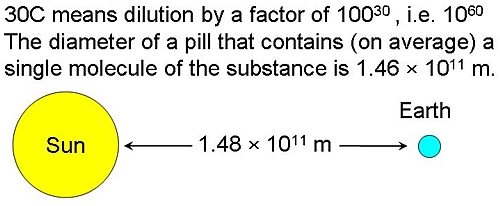
| The bible of homeopaths is Hahnemann’s Organon der rationellen Heilkunde, “Organon of the Medical Art”. His views on dosage, as expressed in the six editions of this book are almost as self-contradictory as the other bible. Hahnemann’s writing about ‘vital spirits’ sounds very silly now, but it is language that was quite common at the end of the 18th century, before much was known about medicine or physiology. But his interest in chemistry was entirely sensible. | 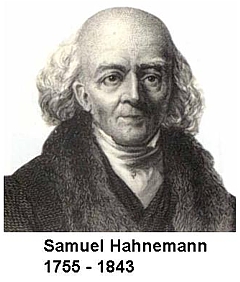 |
Before 1800 Hahnemann started out with the very high doses that were conventional at the time. Unlike most of his contemporaries, he was smart enough to realise that giving 50 g of antimony was killing people so he kept reducing the dose until it was no longer toxic. Unfortunately he (like almost everyone else at the time) didn’t know about controls so he mistook lack of toxicity (because the dose was zero) for a beneficial effect. Nonetheless, for most of his life he did not advocate the extreme dilutions that many modern homeopaths use routinely.
In The Life and Letters of Dr Samuel Hahnemann by Thomas Lindsley Bradford, M.D.(or see Google books edition of the Organon), there is an interesting passage. According to the edition here pp. 237 – 238), this was a note attached to para. #283 in the first edition of the Organon.
| ” The doctrine of the divisibility of matter teaches us that we cannot make a part so small that it shall cease to be something, and that it shall not share all the properties of the whole.” |
Here Hahnemann refers to the doctrine of divisibility, but appears to be saying that dilution can go on for ever. But he also says something that directly contradicts this view (Organon, Dudgeon’s translation see also here, page 239 ). The emphasis is mine.
| “I must say that these procedures seem to show chiefly how high one can go with the potentized attenuation of medicines without their action on the human health becoming nil.“ |
Although this claims that you can dilute a lot, it also admits that if the dilution goes too far the effect would eventually vanish, contrary to the usual homeopathic “principle” that it should keep getting stronger and stronger. and contrary to Hahnemann’s suggestions in other places that he thought matter was infinitely divisible.
This passage shows quite clearly that Hahnemann did not believe that his medicines would work if they were diluted so much that that there were no molecules left. That he believed this is confirmed by a letter that Hahnemann wrote in a letter to a Dr Schreter dated September 13th, 1829. This letter reprimanded Schreter for advocating extremely high dilutions.
| “there must be some limit to the thing. It cannot go on to infinity” The original German version was “Es muss ein Ende geben, es kann nicht bis ins Unendliche weitergehen” |
This confirms that Hahnemann was aware of, and accepted, that matter was not infinitely divisible and his medicines would not work if they contained nothing of the original material.
This attitude is actually not at all surprising, because Hahnemann was an educated man and he had a particular interest in chemistry. He cannot have failed to be aware of Dalton’s atomic theory, which was published between 1805 – 1810, while Hahnemann was writing the first edition of the Organon.
Peter Morrell, in Hahnemann and Homeopathy, says
“These were obviously developments that Hahnemann could not have failed to know about and indeed, was thoroughly excited about, It is clear from many of his asides that he regarded chemistry as the most important science.”
What is astonishing is that I can find no example of Hahnemann ever having mentioned Dalton or Avogadro. Perhaps he was a bit scared by the implications of their suggestions that molecules could not be divided without changing their nature.
The first edition of the Organon was published in 1810. but in the 5th edition appeared 1833, ten years before his death, These dates turn out to be important.
John Dalton (1776 – 1844) was able to estimate relative atomic masses of various molecules, the smallest unit that a chemical can exist in without losing irs identity. His values were soon improved by Amadeo
Avogadro (1776 – 1856), in 1811. Avogadro made the very important proposal that the volume of a gas (strictly, of an ideal gas ) is proportional to the number of atoms or molecules that are present. More precisely, the relationship between the masses of the same volume of different gases (at the same temperature and pressure) corresponds to the relationship between their respective molecular weights. Hence, the relative molecular mass of a gas can be calculated from the mass of a sample of known volume.
BUT neither Avogadro nor Dalton knew how many molecules there were in a given mass of a substance
This is absolutely crucial because it means that, although Hahnemann realised that there was a limit to the dilutions that could be used, he had no way of knowing what that limit was,

The answer to that question was discovered only in 1865, 22 years after the death of Hahnemann. It was discovered not by Avogadro, but by Johann Josef Loschmidt (1821 – 1895). It is Loschmidt, not Avogadro, who discovered the crucial numerical value of ‘Avogadro’s number‘, and in the German literature it is known, properly, as Loschmidt’sche Zahl.
This number is 6.022 x 1023 molecules per mole. One mole of a pure compound is its molecular mass in grams. The molecular mass of carbon (relative to hydrogen) is 12, so 12 grams of carbon contain 6.022 x 1023 carbon atoms. The molecular mass of of strychnine is 334.4 so 334.4 grams of strychnine contain 6.022 x 1023 strychnine molecules.
Armed with the numerical value of Avogadro’s number, it is easy to calculate that a 30 C homeopathic dilution contains nothing whatsoever. More precisely, it would contain, on average, a single molecule in spherical pill with a diameter equal to the distance from the earth to the sun.
But Hahnemann could not have known that. If had lived another 25 years he would almost certainly have renounced the idea of using 30 C dilutions.
He had a good excuse for getting it wrong. He was dead before the knowledge existed to do the calculation
But modern homeopaths have no excuse whatsoever for believing the impossible.
Hahnemann would have thought they were nuts, I suspect. He was too intelligent to believe that medicines that contain no medicine could be effective. In his words, “It cannot go on to infinity”.
Acknowledgement
I very grateful to ‘ Lindy’ for help in checking the references that are cited here, and for helpful discussions.
During the last year, there has been a very welcome flurry of good and informative books about alternative medicine. They are all written in a style that requires little scientific background, even the one that is intended for medical students.
CAM, Cumming | Trick or Treatment | Snake Oil Science |
Testing treatments | Suckers | Healing, Hype or Harm
I’ll start with the bad one, which has not been mentioned on this blog before.
Complementary and Alternative medicine. An illustrated text.
by Allan D. Cumming, Karen R. Simpson and David Brown (and 12 others). 94 pages, Churchill Livingstone; 1 edition (8 Dec 2006).
| The authors of this book sound impressive
Allan Cumming, BSc(Hons), MBChB, MD, FRCP(E), Professor of Medical Education and Director of Undergraduate Learning and Teaching, and Honorary Consultant Physician, College of Medicine and Veterinary Medicine, University of Edinburgh, Edinburgh, UK; Karen Simpson, BA(Hons), RN, RNT, Fellow in Medical Education, College of Medicine and Veterinary Medicine David Brown, MBChB, DRCOG, General Practitioner, The Murrayfield Medical Centre, and Honorary Clinical Tutor, University of Edinburgh |
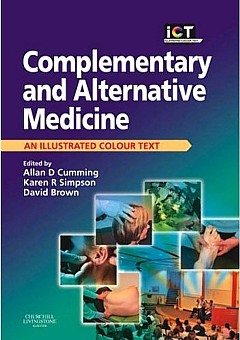 |
Sadly, this is a book so utterly stifled by political correctness that it ends up saying nothing useful at all. The slim volume is, I have to say, quite remarkably devoid of useful information. Partly that is a result of out-of-date and selective references (specially in the chapters written by alternative practitioners),
But the lack of information goes beyond the usual distortions and wishful thinking. I get the strong impression is that it results not so much for a strong commitment to alternative medicine (at least by Cumming) as from the fact that the first two authors are involved with medical education. It seems that they belong to that singularly barmy fringe of educationalists who hold that the teacher must not give information to s student for fear of imparting bias. Rather the student must be told how to find out the information themselves. There is just one little problem with this view. It would take about 200 years to graduate in medicine.
There is something that worries me about medical education specialists. Just look at the welcome given by Yale’s Dean of Medical Education, Richard Belitsky, to Yale’s own division of “fluid concepts of evidence”, as described at Integrative baloney @ Yale, and as featured on YouTube. There are a lot of cryptic allusions to alternative forms of evidence in Cumming’s book too, but nothing in enough detail to be useful to the reader.
What should a book about Alternative medicine tell you? My list would look something like this.
- Why people are so keen to deceive themselves about the efficacy of a treatment
- Why it is that are so often deceived into thinking that something works when it doesn’t
- How to tell whether a medicine works better than placebo or not,
- Summaries of the evidence concerning the efficacy and safety of the main types of alternative treatments.
The Cumming book contains chapters with titles like these. It asks most of the right questions, but fails to answer any of them. There is, time and time again, the usual pious talk about the importance of evidence, but then very little attempt to tell you what the evidence says. When an attempt is made to mention evidence, it is usually partial and out of date. Nowhere are you told clearly about the hazards that will be encountered when trying to find out whether a treatment works.
| The usual silly reflexology diagram is reproduced in Cumming’s introductory chapter, but with no comment at all, The fact that it is obviously total baloney is carefully hidden from the reader.. What is the poor medical student meant to think when they perceive that it is totally incompatible with all the physiology they have learned? No guidance is offered. | 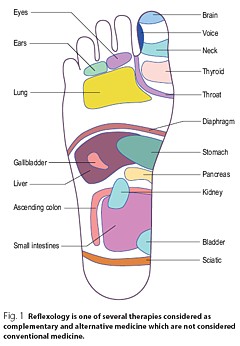 |
| You will look in vain for a decent account of how to do a good randomised controlled trial, though you do get a rather puerile cartoon, The chapter about evidence is written by a librarian. Since the question of evidence is crucial, this is a fatal omission. | 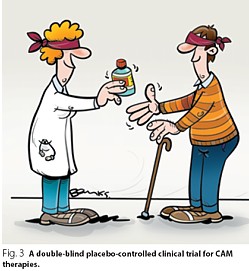 |
Despite the lack of presentation of evidence that any of it works, there seems to be an assumption throughout the book that is is desirable to integrate alternative medicine into clinical practice. In Cumming’s chapter (page 6) we see

Since it would not be in the interests of patients to integrate treatments that don’t work with treatments that do work, I see only two ways to explain this attitude. Either the authors have assumed than most alternative methods work (in which case they haven’t read the evidence), or they think integration is a good idea even if the treatment doesn’t work. Neither case strikes me as good medical education.
The early chapters are merely vague and uninformative. Some of the later chapters are simply a disgrace.
Most obviously the chapter on homeopathy is highly selective and inaccurate, That is hardly surprising because it is was written by Thomas Whitmarsh, a consultant physician at Glasgow Homeopathic Hospital (one that has still survived). It has all the usual religious zeal of the homeopath. I honestly don’t know whether people like Whitmarsh are incapable of understanding what constitutes evidence, or are simply too blinded by faith to even try. Since the only other possibility is that they are dishonest, I suppose it must be one of the former.
The chapter on “Nutritional therapy” is also written by a convert and is equally misleading piece of special pleading.
The same is true of the chapter on Prayer and Faith Healing. This chapter reproduces the header of the Cochrane Review on “Intercessory prayer for the alleviation of Ill Health”, but then proceeds to ignore entirely its conclusion “Most of the studies show no real differences”).
If you want to know about alternative medicine, don’t buy this book. Although this book was written for medical students, you will learn a great deal more from any of the following books, all of which were written for the general public.
Trick or Treatment
by Simon Singh and Edzard Ernst, Bantam Press, 2008
| Simon Singh is the author of many well-known science books, like Fermat’s Last Theorem. Edzard Ernst is the UK’s first professor of complementary and alternative medicine.
Ernst, unlike Cumming et. al is a real expert in alternative medicine. He practised it at an early stage in his career and has now devoted all his efforts to careful, fair and honest assessment of the evidence. That is what this book is about. It is a very good account of the subject and it should be read by everyone, and certainly by every medical student. |
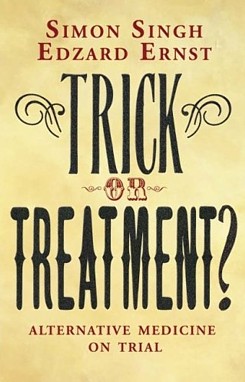 |
Singh and Ernst follow the sensible pattern laid out above, The first chapter goes in detail into how you distinguish truth from fiction (a little detail often forgotten in this area).
The authors argue, very convincingly, that the development of medicine during the 19th and 20th century depended very clearly on the acceptance of evidence not anecdote. There is a fascinating history of clinical trials, from James Lind (lemons and scurvy), John Snow and the Broad Street pump, Florence Nightingale’s contribution not just to hygiene, but also to the statistical analysis that was needed to demonstrate the strength of her conclusions (she became the first female member of the Royal Statistical Society, and had studied under Cayley and Sylvester, pioneers of matrix algebra).
There are detailed assessments of the evidence for acupuncture, homeopathy, chiropractic and herbalism, and shorter synopses for dozens of others. The assessments are fair, even generous in marginal cases.
Acupunture. Like the other good books (but not Cumming’s), it is pointed out that acupuncture in the West is not so much the product of ancient wisdom (which is usually wrong anyway), but rather a product of Chinese nationalist propaganda engineered by Mao Tse-tung after 1949. It spread to the West after Nixon’s visit Their fabricated demonstrations of open heart surgery under acupuncture have been known since the 70s but quite recently they managed again to deceive the BBC It was Singh who revealed the deception. The conclusion is ” . . . this chapter demonstrates that acupuncture is very likely to be acting as nothing more than a placebo . . . ”
Homeopathy. “hundreds of trials have failed to deliver significant or convincing evidence to support the use of homeopathy for the treatment of any particular ailment. On the contrary, it would be to say that there is a mountain of evidence to suggest that homeopathic remedies simply do not work”.
Chiropractic. Like the other good books (but not Cumming’s) there is a good account of the origins of chiropractic (see, especially, Suckers). D.D. Palmer, grocer, spiritual healer, magnetic therapist and fairground quack, finally found a way to get rich by removing entirely imaginary ‘subluxations’. They point out the dangers of chiropractic (the subject of court action), and they point out that physiotherapy is just as effective and safer.
Herbalism. There is a useful table that summarises the evidence. They conclude that a few work and most don’t Unlike homeopathy, there is nothing absurd about herbalism, but the evidence that most of them do any good is very thin indeed.
| “We argue that it is now the time for the tricks to stop, and for the real treatments to take priority. In the name of honesty, progress and good healthcare, we call for scientific standards, evaluation and regulation to be applied to all types of medicine, so that patients can be confident that they are receiving treatments that demonstrably generate more harm than good.” |
Snake Oil Science, The Truth about Complementary and Alternative Medicine.
R. Barker Bausell, Oxford University Press, 2007
Another wonderful book from someone who has been involved himself in acupuncture research, Bausell is a statistician and experimental designer who was Research Director of a Complementary and Alternative Medicine Specialised Research Center at the University of Maryland.
This book gives a superb account of how you find out the truth about medicines, and of how easy it is to be deceived about their efficacy.
I can’t do better than quote the review by Robert Park of the American Physical Society (his own book, Voodoo Science, is also excellent)
| “Hang up your lantern, Diogenes, an honest man has been found. Barker Bausell, a biostatistician, has stepped out of the shadows to give us an insider’s look at how clinical evidence is manipulated to package and market the placebo effect. Labeled as ‘Complementary and Alternative Medicine’, the placebo effect is being sold, not just to a gullible public, but to an increasing number of health professionals as well. Bausell knows every trick and explains each one in clear language” | 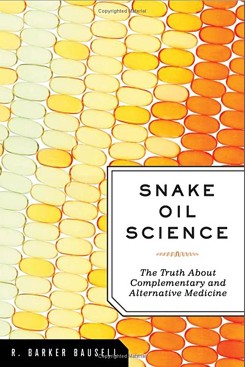 |
Bausell’s conclusion is stronger than that of Singh and Ernst.
“There is no compelling, credible scientific evidence to suggest that any CAM therapy benefits any medical condition or reduces any medical symptom (pain or otherwise) better than a placebo”.
Here are two quotations from Bausell that I love.
[Page 22] ” seriously doubt, however, that there is a traditional Chinese medicine practitioner anywhere who ever stopped performing acupuncture on an afflicted body in the presence of similarly definitive negative evidence. CAM therapists simply do not value (and most cases, in my experience, do not understand) the scientific process”
And even better,
[Page39] “But why should nonscientists care one iota about something as esoteric as causal inference? I believe that the answer to this question is because the making of causal inferences is part of our job description as Homo Sapiens.”
Testing Treatments: Better Research for Better Healthcare
by Imogen Evans, Hazel Thornton, Iain Chalmers, British Library, 15 May 2006
You don’t even need to pay for this excellent book (but buy it anyway, eg from Amazon). If you can’t afford, £15 then download it from the James Lind Library.
| This book is a unlike all the others, because it is barely mentions alternative medicine. What it does, and does very well, is to describe he harm that can be done to patients when they are treated on the basis of guesswork or ideology, rather than on the basis of proper tests. This, of course, is true whether or not the treatment is labelled ‘alternative’.
It is worth noting that one of the authors of this book is someone who has devoted much of his life to the honest assessement of evidence, Sir Iain Chalmers, one of the founders of the Cochrane Collaboration , and Editor of the James Lind Library . |
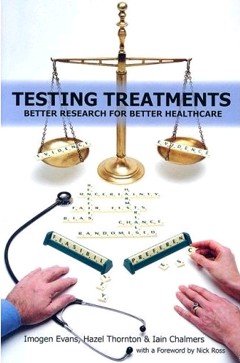 |
A central theme is that randomised double blind trial are essentially the only way to be sure you have the right answer. One of the examples that the authors use to illustrate this is Hormone Replacement Therapy (HRT). For over 20 years, women were told that HRT would reduce their risk of heart attacks and strokes. But when, eventually, proper randomised trials were done, it was found that precisely the opposite was true. The lives of many women were cut short because the RCT had not been done,
The reason why the observational studies gave the wrong answer is pretty obvious. HRT was used predominantly by the wealthier and better-educated women. Income is just about the best predictor of longevity. The samples were biassed, and when a proper RCT was done it was revealed that the people who used HRT voluntarily lived longer despite the HRT, not because of it. It is worth remembering that there are very few RCTs that test the effects of diet. And diet differs a lot between rich and poor people. That, no doubt, is why there are so many conflicting recommendations about diet. And that is why “nutritional therapy” is little more than quackery. Sadly, the media just love crap epidemiology. One of the best discussions of this topics was in Radio 4 Programme. “The Rise of the Lifestyle Nutritionists“, by Ben Goldacre.
One of the big problems in all assessment is the influence of money, in other words corruption, The alternative industry is entirely corrupt of course, but the pharmaceutical industry has been increasingly bad. Testing Treatments reproduces this trenchant comment.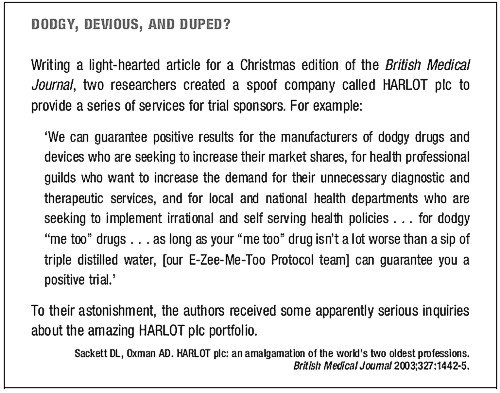
Suckers. How Alternative Medicine Makes Fools of Us All
Rose Shapiro, Random House, London 2008
| I love this book. It is well-researched, feisty and a thoroughly good read.
It was put well in the review by George Monbiot.
The chapters on osteopathy and chiropractic are particularly fascinating. |
 |
This passage describes the founder of the chiropractic religion.
“By the 1890s Palmer had established a magnetic healing practice in Davenport, Iowa, and was styling himself ‘doctor’. Not everyone was convinced as a piece about him in an 1894 edition of the local paper, the Davenport Leader, shows.”
A crank on magnetism has a crazy notion hat he can cure the sick and crippled with his magnetic hands. His victims are the eak-minded, ignorant and superstitious, those foolish people who have been sick for years and have become tired of the regular physician and want health by the short-cut method . . . he has certainly profited by the ignorance of his victims . . . His increase in business shows what can be done in Davenport, even by a quack”
Over 100 years later, it seems that the “weak-minded, ignorant and superstitious” include the UK’s Department of Health, who have given these quacks a similar status to the General Medical Council.
The intellectual standards of a 19th Century mid-western provincial newspaper leader writer are rather better than the intellectual standards of the Department of Health, and of several university vice-chancellors in 2007.
Healing Hype or Harm
Edited by Imprint Academic (1 Jun 2008)
Download the contents page
My own chapter in this compilation of essays, “Alternative medicine in UK Universities” is an extended version of what was published in Nature last year (I don’t use the term CAM because I don’t believe anything can be labelled ‘complementary’ until it has been shown to work). Download a copy if the corrected proof of this chapter (pdf).
| Perhaps the best two chapters, though, are “CAM and Politics” by Rose and Ernst, and “CAM in Court” by John Garrow.
CAM and politics gives us some horrifiying examples of the total ignorance of almost all politicians and civil servants about the scientific method (and their refusal to listen to anyone who does understand it). CAM in Court has some fascinating examples of prosecutions for defrauding the public. Recent changes in the law mean we may be seeing a lot more of these soon. Rational argument doesn’t work well very well with irrational people. But a few homeopaths in jail for killing people with malaria would probably be rather effective. |
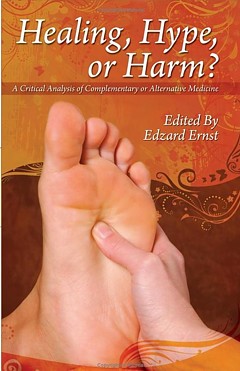 |
Follow-up
Healing, Hype or Harm has had some nice reviews, That isn’t so surprising from the excellent Harriet Hall at Science-Based Medicine. The introduction to my chapter was a fable about the replacemment of the Department of Physics and Astronomy by the new Department of Alternative Physics and Astrology. It was an unashamedly based on Laurie Taylor’e University of Poppleton column. Hall refers to it as “Crislip-style”, a new term to me. I guess the incomparable Laurie Taylor is not well-known in the USA, Luckily Hall gives a link to Mark Crislip’s lovely article, Alternative Flight,
“Americans want choice. Americans are increasingly using alternative aviation. A recent government study suggests that 75% of Americans have attempted some form of alternative flight, which includes everything from ultralights to falling, tripping and use of bungee cords.”
“Current airplane design is based upon a white male Western European model of what powered flight should look like. Long metal tubes with wings are a phallic design that insults the sensibilities of women, who have an alternative, more natural, emotional, way of understanding airplane design. In the one size fits all design of allopathic airlines, alternative designs are ignored and airplane design utilizing the ideas and esthetics of indigenous peoples and ancient flying traditions are derided as primitive and unscientific, despite centuries of successful use.”
Metapsychology Online Reviews doesn’t sound like a promising title for a good review of Healing, Hype or Harm, but in fact their review by Kevin Purday is very sympathetic. I like the ending.
“One may not agree with everything that is written in this book but it is wonderful that academic honesty is still alive and well.”
| A report has appeared on Regulation of Practitioners of Acupuncture, Herbal Medicine, Traditional Chinese Medicine. The report is written by people all of whom have vested interests in spreading quackery. It shows an execrable ability to assess evidence, and it advocates degrees in antiscience It would fail any examination. Sorry, Prof Pittilo, but it’s gamma minus.[Download the report] |  |
Alice Miles put it well in The Times, today.
“This week came the publication of the “Report to Ministers from the Department of Health Steering Group on the Statutory Regulation of Practitioners of Acupuncture, Herbal Medicine, Traditional Chinese Medicine and Other Traditional Medicine Systems Practised in the UK”. Otherwise known as twaddle.” . . .
“Regulate the practitioners – for safety, note, not for efficacy, as that is impossible to prove – and you give them official recognition. From recognition it is but a short hop to demand and then prescription: packet of Prozac, bit of yoga and a bag of dodgy herbs for you, sir.” . . .
“The Government responded on Monday – with a three-month consultation. So join in. Write to the Health Minister Ben Bradshaw at Richmond House, 79 Whitehall, SW1A 2NS. Write, on behalf of the NHS: “What I want for my 60th birthday is… the chance to provide medical, dental, and nursing care to all. And absolutely nothing else.”
Judging by Ben Bradshaw’s speech to the Prince’s Foundation, there may be a problem in conveying to him the evidence, but one can and must try.
Why is it that a health joutnalist can do so much better than a university head? Yes, the chair of the steering group is Professor R. Michael Pittilo BSc PhD CBiol FIBiol FIBMS FRSH FLS FRSA, Principal and Vice-Chancellor of The Robert Gordon University, Aberdeen. Despite all those impressive-lookin initials after his name, I believe that this is a very bad report.
Here is something about Prof Pittilo from his university’s web site (the emphasis is mine).
Professor Michael Pittilo joined The Robert Gordon University, Aberdeen, as Principal and Vice-Chancellor on 5th September, 2005.
After postdoctoral research on arterial disease at the University of London, he was appointed to Kingston University where he became Head of Life Sciences. In 1995 he became Foundation Dean of the Faculty of Health and Social Care Sciences at Kingston University and St George’s Medical School (University of London). He was appointed Pro Vice Chancellor at the University of Hertfordshire in 2001.
Professor Pittilo has held a number of additional roles, including chairing Department of Health working groups, and as a trustee for the Prince of Wales’s Foundation for Integrated Health. “
Notice that Prof Pittilo is a Trustee of the Prince’s Foundation for Integrated Health, source of some of the least reliable information about alternative medicine to be found anywhere.
This steering group is, as so often, a nest of vested interests. It does not seem to have on it any regular medical or clinical scientist whatsoever. Why not? They just might produce some embarrassing facts perhaps? Like most government committees its members seem to have been chosen to produce the desired outcome.
For a start, the university run by Prof Pittilo, Robert Gordon’s University, is itself involved in a few antiscientific courses. Since his report recommends that degrees in quackery should become mandatory, I expect he’d welcome the chance to run more. Amazingly, Robert Gordon’s University runs an Introduction to Homeopathy, just about the daftest of all the common sorts of magic medicine.
Most of the the members of the steering group represent vested interests, though strangely this is not made clear in the list of members. An earlier report, in 2006, from the steering group was more open about this. Twelve of the members of the group represent Herbal Medicine, Chinese Medicine and Acupuncture (four from each). Most of the rest are lay members or bureaucrats. With membership like that it is, I suppose, not surprising that the assessment of evidence is, to put it kindly, grossly distorted and woefully inadequate.
The report starts badly by failing to mention that the House of Lords report (2000), and the government’s response to it, set the following priorities. Both state clearly
“… we recommend that three important questions should be addressed in the following order . .
- (1) does the treatment offer therapeutic benefits greater than placebo?
- (2) is the treatment safe?
- (3) how does it compare, in medical outcome and cost-effectiveness, with other forms of treatment?
The word ‘placebo’ does not occur a single time in the main report (and only twice in the text of the seven appendices). But they do say (page 11):
“We recommend that public funding from the NHS should be used to fund CAM therapies where there is evidence of efficacy, safety and quality assurance.”
The evidence
The problem is that the assessment of the evidence for efficacy in the report is pathetically poor. The report, sad to say, consists essentially of 161 pages of special pleading by the alternative medicine industry, served up with the usual large dose of HR gobbledygook.
There is really no excuse for this utterly incompetent assessment. There have been plenty of books this year alone that make excellent summaries of the evidence, mostly written for the lay public. They should, therefore, be understandable by any university vice-chancellor (president). The one benefit of the upsurge in public interest in magic medicine is that there are now quite a lot of good clinical trials, and when the trials are done properly, they mostly confirm what we thought before: in most cases the effects are no more than placebo.
Here is one example. Annexe1 concerns “Developing Research and Providing an Evidence Base for Acupuncture and Herbal/Traditional Medicine Treatment”. The wording of the title itself suggests, rightly, that this evidence base does not exist, in which case why on earth are we talking about them as “professions”? The discussion of the evidence in Annexe 1 is nothing if not partial. But what do you expect if you ask herbalists to assess herbal medicine? An honest assessment would put them out of business. The eternal mantra of the alternative industry appears as usual, “Absence of evidence is, of course, not evidence of absence”. True of course, but utterly irrelevant. Annexe 1 says
“Acupuncture is a complex intervention and lack of a suitable placebo control has hindered efforts to evaluate efficacy”
This is simply untrue, In recent years enormous efforts have been put into devising controls for assessment of acupuncture, but they are entirely ignored here. One thing that has been established quite clearly is that it makes no difference where you put the needles, so all the talk of Qi and meridians is obvious mumbo-jumbo.
Have the authors of Annexe 1, and Professor Pittilo, not read the relevant studies? Two books this year have dealt with the question of evidence with great care. They are both by people who have been involved personally with acupuncture research, Prof Edzard Ernst and Dr Barker Bausell. Edzard Ernst is the UK’s first Professor of Complementary Medicine. Barker Bausell was research director of an NIH-funded Complementary and Alternative Medicine Specialized Research Center at the University of Maryland.
 |
 |
Singh and Ernst discuss thoroughly the question of controls and assess all the evidence carefully. Their conclusions include the following.
- The traditional principles of acupuncture are deeply flawed, as there is no evidence at all to demonstrate the existence of Ch’i [Qi] or meridians.
- By focussing on the increasing number of high-quality research papers, reliable conclusions from systematic reviews make it clear that acupuncture does not work for a whole range of conditions, except as a placebo.
- In short, the evidence is neither consistent nor convincing. It is borderline.
Barker Bausell was himself involved in designing and analysing trialsof acupuncture. His conclusions are even less positive.
“There is no compelling, credible scientific evidence to suggest that any CAM therapy benefits any medical condition or reduces any medical symptom (pain or otherwise) better than a placebo”.
These are serious authors with direct experience in CAM research, which is more than can be said of anyone on the steering group. Why are their conclusions ignored entirely? That is sheer incompetence.
Degrees in anti-science
One conclusion of the report is that
“The threshold entry route to the register will normally be through a Bachelor degree with Honours”
This is utter nonsense. It is quite obvious surely that you can’t award honours degrees until after you have the evidence. You can read on page 55 of the report
“3a: Registrant acupuncturists must:
understand the following aspects and concepts for traditional East-Asian acupuncture:
– yin/yang, /5 elements/phases, eight principles, cyclical rhythms, qi ,blood and body fluids, different levels of qi, pathogenic factors, 12 zang fu and 6 extraordinary fu, jing luo/ meridians, the major acupuncture points, East-Asian medicine disease categorisation, the three burners, the 4 stages/levels and 6 divisions
– causes of disharmony/disease causation
– the four traditional diagnostic methods: questioning, palpation, listening and observing”
This is utter baloney. Anyone who advocates giving honours degrees in such nonsense deserves to be fired for bringing his university into disrepute (and, in the process, bringing all universities and science itself into disrepute).
That includes also degrees that teach that “amethysts emit high yin energy“.
So what should be done?
If making peole do degrees in mumbo-jumbo is not the answer, what is? Clearly it would be far too draconian to try to ban quackery (and it would only increase its popularity anyway).
The answer seems to me to be quite simple. All that needs to done is to enforce existing laws. It is already illegal to sell contaminated and poisonous goods to the public. It is already illegal to make fraudulent advertisemants and to sell goods that are not as described on the label.
The only problem is that the agencies that enforce these rules are toothless and that there are a lot of loopholes and exceptions that work in favour of quackery. I have tried myself to complain about mislabelling of homeopathic pills to the Office of Fair Trading on the grounds that are labelled Arnica 30C but contain no Arnica. They solemnly bought a bottle and sent it to an analyst and of course they found no arnica, But nothing happened, because an exception to the usual law applies to homeopathic pills.
The Advertising Standards Authority is good as far as it goes. They quickly told Boots Pharmacies to withdraw advertisements that claimed CoQ10 “increased vitality”. But they can exact no penalties and they can’t deal with lies that are told to you orally, or with anything at all on the web.
The Health Professions Council (HPC) says that one of the criteria for registering new professions is aspirant groups must “Practise based on evidence of efficacy”. If that were actually applied, none of this process would occur anyway. No doubt the HPC will fail to apply its own criteria. On past form, it can be expected to adopt a “fluid concept of evidence“.,
One more thing, New European legislation was described recently in the BMJ
“Consumers in the United Kingdom are to receive stronger legal safeguards against products that claim, without any identifiable scientific evidence, to provide physical and mental health benefits such as tackling obesity or depression.”
“The scope of the legislation is deliberately wide and is the biggest shake up in consumer law for decades. It targets any unfair selling to consumers by any business.”
Politicians seem to be immune to rational argument when it comes to quackery. But a few legal actions under these laws could bring the house of cards tumbling so fast that this gamma-minus report would become rapidly irrelevant. There will be no shortage of people to bring the actions. I can’t wait.
Follow up
Dominic Lawson, 24 June 2008. An excellent column appeared today in the Independent. Dominic Lawson writes about the Pittilo report: “So now we will have degrees in quackery. What, really, is the difference between acupuncture and psychic surgery?“. The reference to that well known conjuring trick, “psychic surgery” as a “profession”, revealed here, causes Lawson to say
“It makes it clear that the lunatics have taken over the asylum. For a start, how could Philip Hunt, previously director of the National Association of Health Authorities and Trusts, possibly have thought that “psychic healing” constituted a “profession” – let alone one which would “develop its own system of voluntary self-regulation?”
“One can see how this might fit in with the Government’s “never mind the quality, feel the width” approach to university education. One can also see how established practitioners of such therapies might see this as a future source of income – how pleasant it might be to become Visiting Professor of Vibrational Medicine at the University of Westminster.
Thus garlanded with the laurels of academic pseudo-science, the newly professionalised practitioners of “alternative medicine” can look down on such riff-raff as the “psychic surgeons”
Once again I have to ask, how is it that we have to rely on journalists to prevent vice-chancellors eroding academic standards; indeed eroding simple common sense? I guess it is just another sign of the delusional thinking engendered by the culture of managerialism that grips universities.
The extent to which irrationality has become established in US Medicine is truly alarming I wrote about Quackademics in the USA and Canada on my last trip to the USA, and on my May trip I visited Yale, where I decided to try a full frontal attack. [download the poster]

Several US blogs have written about this phenomenon. For example the incomparable Orac at the The Academic Woo Aggregator , and Dr RW (R.W. Donnell) , see particularly his articles on How did pseudoscience get admitted to medical school? and What is happening to our medical schools? Abraham Flexner is turning over in his grave. Excellent US stuff too at Science-based Medicine (try this and this). There is also a good analysis of what’s happening at Yale by Sandy Szwarc at Junkfood Science.
Remember that the terms ‘integrative’ and ‘complementary’ are euphemisms coined by quacks to make their wares sound more respectable, There is no point integrating treatments that don’t work with treatments that do work.
‘Integrative Medicine’ at Yale says, like all the others on the roll of shame, says “we aim to improve awareness and access to the best in evidence-based, comprehensive medical care available worldwide”. They all pay lip service to being “evidence based”, but there is just one snag. It is untrue. In almost all cases, the evidence is either negative or absent. But this does not put them off for a moment. The whole process is simply dishonest.
The evidence
The evidence has been summarised in several books recently, The following books are particularly interesting because they are all ‘views from the inside. Edzard Ernst is the UK’s first Professor of Complementary Medicine. Barker Bausell was research director of an NIH funded Complementary and Alternative Medicine Specialized Research Center at the University of Maryland.
The first two books go through the evidence fairly and carefully. They show no bias against alternative treatments (if anything, I’d say they are rather generous in cases of doubt).
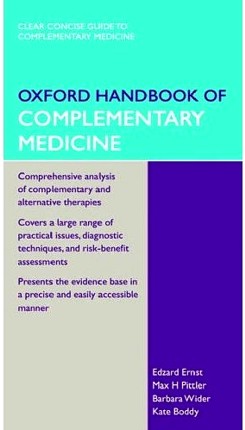 |
 |
For a first class US account try Barker Bausell’s Snake Oil Science
Bausell’s book gives an excellent account of how to test treatments properly, and of all the ways you can be fooled into thinking something works when it doesn’t. Bausell concludes
|
 |
| For an excellent account of how to find the truth, try Testing Treatments (Evans. Thornton and Chalmers). One of the authors, Iain Chalmers, is a founder of the Cochrane library and a world authotity on how to separate medical fact from medical myth. | 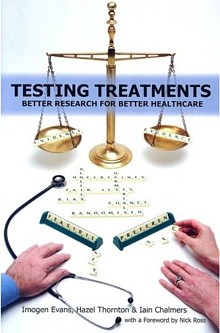 |
It can now be said with some certainty that the number of alternative treatments that have been shown to work better than placebo is very small, and quite possibly zero,
With that settled, what’s going on at Yale (and many others on the roll of shame)?
David L. Katz, MD, MPH, FACPM, FACP, is founder and director of the Integrative Medicine Center (IMC) at Griffin Hospital in Derby, Connecticut. He is also an associate professor, adjunct, of Public Health and director of the Prevention Research Center (PRC) at the Yale University School of Medicine in New Haven, Connecticut.
That sounds pretty respectable. But he is into not just good nutrition, exercise, relaxation and massage, but also utterly barmy and disproved things like homeopathy and ‘therapeutic touch’.
| Watch the movie
It so happens that Yale recently held an “Integrative Medicine Scientific Symposium”. Can we find the much vaunted evidence base there? That is easy to answer because three hours of this symposium have appeared on YouTube. So this is the public face of Yale medical school. There’s some interesting history and a great deal of bunkum and double-speak. To save you time, I’ve cut out about 6 minutes from the movies. |
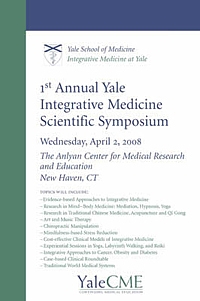 |
View or download the movie here > [18.5 Mb, flv file].
Dean of education Richard Belitsky and Dr David Katz
Pretty remarble uh? Dr Katz goes through several different trials, all of which come out negative. And what is his conclusion? You guessed.
His conclusion is not that the treatments don’t work but that we need a “more fluid concept of evidence” .
It’s equally bizarre to hear Richard Belitsky, Dean of Medical Education at Yale saying he is “very proud” of this betrayal of enlightenment values. If this is what Yale now considers to be education, it might be better to go somewhere else.
This is not science. It isn’t even common sense. It is a retreat to the dark ages of medicine when a physician felt free to guess the answer. In fact it’s worse. In the old days there was no evidence to assess. Now there is a fair amount of evidence, but Dr Katz feels free to ignore it and guess anyway. He refers to teaching about evidence as ‘indoctrination’, a pretty graphic illustration of his deeply anti-scientific approach to knowledge. And he makes a joke about having diverted a $1m grant from CDC, for much needed systematic reviews, into something that fits his aims better.
Katz asks, as one must, what should we do if there is no treatment that is known to help a patient. That is only too frequent a problem. The reasonable thing to say is “there is no treatment that is known to help”. But Dr Katz thinks it’s better to guess an answer. There is nothing wrong with placebo effects but there is everything wrong with trying to pretend that you are doing more than give placebos. Perhaps he should consider the dilemmas of alternative medicine.
You can read about more about Yale’s activities here and in interviews here. Dr Katz says “The founding approach—and I think Andrew Weil, MD, gets the lion’s share of credit for establishing the concept —is training conventional practitioners in complementary disciplines”. Let’s take a look at this hero. Try, for example, Arnold Relman’s “A trip to Stonesville“.
“According to Weil, many of his basic insights about the causes of disease and the nature of healing come from what he calls “stoned thinking,” that is, thoughts experienced while under the influence of psychedelic agents or during other states of “altered consciousness” induced by trances, ritual, magic, hypnosis, meditation, and the like.”
“To the best of my knowledge, Weil himself has published nothing in the peer-reviewed medical literature to document objectively his personal experiences with allegedly cured patients or to verify his claims for the effectiveness of any of the unorthodox remedies he uses.”
Here is the advertisment for Andrew Weil’s nutrition symposium.

Not only does this yet again propagate the great antioxidant myth, but a few moments with Google show that it is riddled with vested interests, as already pointed out on Quackademics in USA and Canada.
What has brought medical schools down to this level?
That isn’t hard to see, The main thing is simply money. Very few university administrators have the intellectual integrity to turn down money, whatever the level of dishonesty that is required by its acceptance. You can buy a lot of silence for $100m
The US Taxpayer has given almost a billion dollars, via NIH.

Wallace Sampson, MD says of NCCAM
“. . it has not proved effectiveness for any ‘alternative’ method. It has added evidence of ineffectiveness of some methods that we knew did not work before NCCAM was formed”
“Its major accomplishment has been to ensure the positions of medical school faculty who might become otherwise employed in more productive pursuits.”
“Special commercial interests and irrational, wishful thinking created NCCAM. It is the only entity in the NIH devoted to an ideological approach to health.”
NCCAM has given money from some very dubious trials too, Both Orac on Respectful Insolence and Dr RW (R.W. Donnell) have written recently about the NCCAM-funded trial of “chelation therapy”, as first exposed in a devastating article by Kimball C. Atwood IV, MD; Elizabeth Woeckner, AB, MA; Robert S. Baratz, MD, DDS, PhD; Wallace I. Sampson, MD on Medscape Today. This is a $30 million, 5-year, phase 3 Trial to Assess Chelation Therapy (TACT) for coronary artery disease.
“But how did such a crappy study ever come to be, much less be funded by the NIH to the tune of $30 million? The answer, not surprisingly, involves one of the foremost promoters of quackery in the federal government, Representative Dan Burton (R-IN).”
“We conclude that the TACT is unethical, dangerous, pointless, and wasteful. It should be abandoned.”
Orac comments
“TACT is not the only example of an unethical and scientifically worthless trial being funded not because the science is compelling but because powerful lobbies and legislators who are true believers in woo applied pressure to the NIH to do them”
The Bravewell Collaboration is the other major source of money. Forbes Business says “Bravewell is not some flaky New Age group”. Well dead wrong there, That is precisely what it is.
This group of ultra-rich people, according to its boss, Christy Mack, has a
So Bravewell is corrupting the search for real knowledge and real cures with big bucks. You can buy a lot of hokum for $100m. |
 |
The money comes from Morgan Stanley,
|
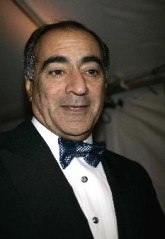 |
Bravewell is run by his wife, Christy Mack (Mack-the-wife?) Vice-President, The C.J. Mack Foundation, Member, Board of Directors, The Bravewell Collaborative.
The Flexner report.
The story of Bravewell stands in chilling contrast to another case of philanthropy. Andrew Carnegie’s foundation financed the report by Abraham Flexner, “Medical Education in the United States and Canada” (1910) [download, 15 Mb] . That report was responsible for dragging medical education out of the dark ages
almost a century ago. It resulted in creation of some of the best medical schools anywhere (including Yale).
“By educational patriotism I mean this: a university has a mission greater than the formation of a large student body or the attainment of institutional completeness, namely, the duty of loyalty to the standards of common honesty, of intellectual sincerity, of scientific accuracy.”
“The tendency to build a system out of a few partially apprehended facts, deductive inference filling in the rest, has not indeed been limited to medicine, but it has nowhere else had more calamitous consequences.”
Flexner (1910).
Now another philanthropist is using big bucks to reverse the process and push medicine back into the 19th century.
Flexner would have thought it quite inconceivable that in 2007 medical schools would be offering Continuing Medical Education in homeopathy.
Why are Yale’s academics so quiet about this?
Perhaps they don’t even know it’s happening. If they say firmly that they don’t want it, it will go,
It’s been done before
Florida State University, allegedly under political pressure, proposed to set up a school of Chiropractic. That would have made it Florida State school of snake-oil salesmanship. What a sad fate. [ Science magazine comment] [comment form Paul Lee] [Comment in St Petersburg Times]
But the academics stopped it. An FSU professor, Albert Stiegman, predicted the future campus map.
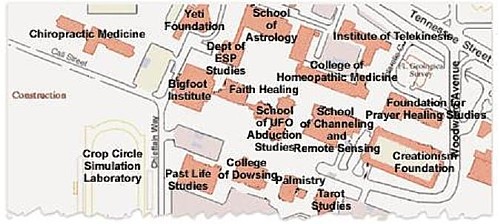
According to FSUnews
“The Florida Board of Governors voted 10-3 Thursday to deny Florida State University’s request to build a chiropractic school.”
“However, the passage of the bill for the chiropractic school by the Legislature seemingly bypassed the Board of Governors.”
In the end, reason won. Let’s hope that Yale follows their example.
Follow up
The problem of Yale has been taken up with great eloquence by some US commentators
Dr RW (R.W, Donnell): “Quackademic Medicine at Yale”
“By the way, where’s the AAMC in all this? Aren’t they supposed to be guardians of integrity and professionalism in medical education? Are they asleep at the switch or is money silencing them too?”
Orac (Respectful Insolence): “Integrative” medicine at Yale: A more “fluid” concept of evidence?”
“after the Dean of the Yale School Medicine embarrassed himself in the introduction by saying he’s proud of how far this nonsense has come, Dr. Katz takes the stage and demonstrates the sort of hostile attitude towards science that, if allowed to take root will be the death of scientific medicine in any meaningful form at U.S. medical schools”
Junkfood Science. Sandy Szwarc on “Quote of the day: ;We need a more fluid concept of evidence’”
“Will healthcare professionals and consumers . . . . speak out against these wellness programs being enacted by government agencies, insurers and employers? Or is the money too good?”
Science-based Medicine. Steven Novella writes on “Changing the rules of evidence“. When alternative medicine people do not like the evidence, they change the rules to get the outcome that they want, as seen so graphically in this post. They have always done this, but it is only recently that this sort of behaviour has been endorsed by places like Yale.
The Macho Response, another US blog, comments bluntly, in “Yale wants a more fluid concept of evidence”
This is beyond embarrassing – it’s a fucking crime – and it’s happening at Yale University and many others.
If you’re in the medical profession (and I know many of my readers are) you need to go here – now.
Kiosque Médias writes as follows
Pour ceux qui s’intéressent à la médecine et à la santé, le blog de David Colquhoun vaut probablement le détour. Ce professeur-chercheur au département de neurosciences, de physiologie et de pharmacologie de l’University College London y décrypte les résultats d’études médicales, en mettant l’accent sur les médecines alternatives. Et il est rarement tendre!
James Randi Newsletter. The hit rate soars after a recommendation this piece by the amazing Randi.
Hokum-Balderdash Assay. Edwardson writes
“Yale University is going to the ducks. It now has an Integrative Medicine program and in April held its first annual Integrative Medicine Scientific Symposium. I think there must’ve been a typo there. They must’ve meant “Ist Annual I.M. Pseudoscientific Symposium.” There! Now we’ve done away with the oxymoron.”
Why is Yale so secretive about its quackery department?,
Most universities are only to keen to boast about their grant income. Not in this case though. When I asked how they funded their quackery, all I got was a letter that had very obviously been drafted by a lawyer.
“As a private institution, Yale University is not generally subject to the U.S. Freedom of Information Act. We therefore respectfully decline to compile and provide the information you have requested.”
So pretty clear signs of guiltiness there.
Dr David Katz, yes, he of the “fluid concept of evidence”, has posted an article, Health Hazards of rhe Blogoshere. If it quacks like a duck . . .
It seems that he has been a bit alarmed by the reaction of the bloggers. It starts, rather pompously, thus.
“Being well educated does not guarantee you’ll always be right, and it certainly doesn’t guarantee everyone will agree with you. But it still matters. Or at least it used to “
But the rest if it reads less like a defence than as an admission of guilt, thus prompting the next item.
Paul Hutchinson’s blog
| A quack who admits it picks out a quotation from Dr Katz’s response and turned into a cartoon, released to the public domain, So here it is. |  |
Respectful Insolence.
Orac comments too, in “Fluid evidence” strikes back: Dr. Katz versus the skeptical blogsophere”. He does a terrific job in taking apart the response from the hapless Dr Katz.
“No, Dr. Katz does not like his first encounter with the medical blogosphere at all. Indeed, he is so unhappy that apparently a few weeks ago he tried t answer the bloggers who had raked him over the coals for blatantly advocating “integrating” unscientific woo like homeopathy with scientific medicine. Unfortunately for him, he did not do a particularly good job of it. Indeed, what most stood out as I read his rejoinder was that he does not answer a single substantive criticism leveled at his comments. Not one. Instead, he does what pretty much all woo-meisters do when criticized for shifting goalposts and appealing to other ways of knowing besides science as a means of “proving” that their preferred fairy dust works; he wraps himself in the mantle of the brave iconoclast willing to challenge accepted dogma and whines about the peons who criticized him, heaping contempt on the bloggers who had the temerity to criticize his advocacy for pseudoscience because to him they have not earned the right to criticize his (at least in his opinion, apparently) greatness in comparison to him.”
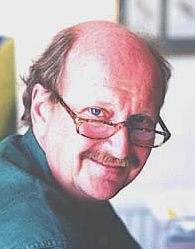 |
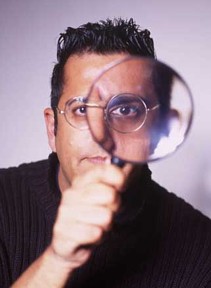 |
The Times published a letter from Edzard Ernst and Simon Singh on April 16th. In their forthcoming book, Trick or Treatment? Alternative Medicine on Trial, they go carefully through all the evidence for all sorts of ‘alternative’ treatments. They find some evidence that a handful of them work. For most the answer is ‘not enough evidence’, and for a number there is good evidence that many of them don’t work to any useful extent.
“Sir, For over two decades the Prince of Wales has been actively promoting alternative medicine and his Foundation for Integrated Health continues to encourage the use of treatments such as homoeopathy or reflexology.””In light of this “rigorous scientific evidence”, we strongly advise that the Prince of Wales and the Foundation for Integrated Health withdraw the publications Complementary Health Care: A Guide for Patients and the Smallwood report. They both contain numerous misleading and inaccurate claims concerning the supposed benefits of alternative medicine. The nation cannot be served by promoting ineffective and sometimes dangerous alternative treatments.”
Thank heavens that someone has the courage to say it as it is.
If only the ineffectual and ill-educated people in the Department of Health wouold do the same. But no, instead they gave £37 000 to the Prince of Wales Foundation to write their make-believe guides. And £900 000 to write nonsense for the Complementary and Natural Healthcare Council (also known as Ofquack), and Skills for Health,
The next day The Times ran an article by their science editor, Mark Henderson, Prince of Wales’s guide to alternative medicine ‘inaccurate’. Natasha Finlayson, of the Prince’s Foundation for Integrated Health, is quoted as saying “The foundation does not promote complementary therapies.”. That takes some beating for sheer bare-faced dishonesty.
Edzard Ernst appeared on the Today Program on 18th April. He was interveiwed by the formidable John Humphrys, along with Kim Lavely, Chief Executive, The Prince’s Foundation for Integrated Health (FIH). Ernst points out that the FIH guide suggests that chiropractic is effective in asthma, and that acupuncture is good for addiction, whereas the evidence says the opposite. Lavely retorts, rather lamely (OK I’m biassed).
Lavely: ” . . . we didn’t attempt to give detailed evidence on every therapy”. “We think they [the public] have the right to know and what doesn’t”
Humphrys: “Well isn’t that the whole point? the professor is saying here is that these things do not work, at least in terms of the claims that are made for them, such as homeopathy and chiropractic . . . ”
Lavely: “There are no claims made in this guide for what works and what doesn’t. What we have said is that some therapies are used for some things but we aren’t saying they are effective for those things . . . “
So, one might ask, what on earth is the use of a guide is it that offers no indication of effectiveness? Lavely’s second quotation contradicts directly her first. A pretty pathetic performance.
Listen to the interview [mp3 file]
The Sunday Times, on April 20th, pblished a pretty good review of Trick of Treatment?. “Their case against the folly, vanity and damage of HRH et al. is hard to argue with.”
Of course, the letters column drew the expected response from the quacks, most verging on the hilarious.
Another blow for the alternative industry came in the same week, The authoratitve Cochrane review confirmed earlier reports that vitamin supplements not only do not help you but some actually increase mortality. The antioxidant myth nevertheless rumbles on, and on, and on. There is too much money in it for it to die easily.
Predictably enough, the conclusions were denied by the Health Food Manufacturers’ Association (HFMA). They wheeled out several pop singers to say how wonderful their products are. Read about that pathetic defence on Holfordwatch.
Who is behind HFMA? Incidentally, HFMA are strangely reticent about the identity of their 120 members. They will not reveal who they are. Does anybody out there know the answer? I’ll buy a good dinner for anyone who can root this out. If it is anything like the ‘Health Supplements Information Service‘ it is likely to be backedby the very big pharmaceutical companies that the alternative industry loves to hate.
Take the test
Prince of Wales Guide
“Reflexologists work with a wide range of conditions including certain types of pain, particularly back and neck pain, migraine and headaches, chronic fatigue, sinusitis, arthritis, insomnia, digestive problems such as irritable bowel syndrome, and constipation, stress-related disorders and menopausal symptoms.”
Singh & Ernst
“The notion that reflexology can be used to diagnose health problems has been disproved and there is no convincing evidence that it is effective for any condition.”
This is a fuller version, with links, of the comment piece published in Times Higher Education on 10 April 2008. Download newspaper version here.
If you still have any doubt about the problems of directed research, look at the trenchant editorial in Nature (3 April, 2008. Look also at the editorial in Science by Bruce Alberts. The UK’s establishment is busy pushing an agenda that is already fading in the USA.
Since this went to press, more sense about “Brain Gym” has appeared. First Jeremy Paxman had a good go on Newsnight. Skeptobot has posted links to the videos of the broadcast, which have now appeared on YouTube.
Then, in the Education Guardian, Charlie Brooker started his article about “Brain Gym” thus
Dr Aust’s cogent comments are at “Brain Gym” loses its trousers. |
 |
The Times Higher’s subeditor removed my snappy title and substituted this.
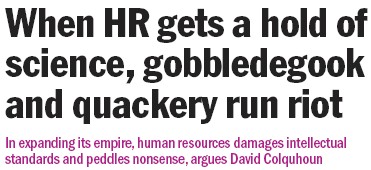
So here it is.
“HR is like many parts of modern businesses: a simple expense, and a burden on the backs of the productive workers”, “They don’t sell or produce: they consume. They are the amorphous support services” .
So wrote Luke Johnson recently in the Financial Times. He went on, “Training advisers are employed to distract everyone from doing their job with pointless courses”. Luke Johnson is no woolly-minded professor. He is in the Times’ Power 100 list, he organised the acquisition of PizzaExpress before he turned 30 and he now runs Channel 4 TV.
Why is it that Human Resources (you know, the folks we used to call Personnel) have acquired such a bad public image? It is not only in universities that this has happened. It seems to be universal, and worldwide. Well here are a few reasons.
Like most groups of people, HR is intent on expanding its power and status. That is precisely why they changed their name from Personnel to HR. As Personnel Managers they were seen as a service, and even, heaven forbid, on the side of the employees. As Human Resources they become part of the senior management team, and see themselves not as providing a service, but as managing people. My concern is the effect that change is having on science, but it seems that the effects on pizza sales are not greatly different.
The problem with having HR people (or lawyers, or any other non-scientists) managing science is simple. They have no idea how it works. They seem to think that every activity
can be run as though it was Wal-Mart That idea is old-fashioned even in management circles. Good employers have hit on the bright idea that people work best when they are not constantly harassed and when they feel that they are assessed fairly. If the best people don’t feel that, they just leave at the first opportunity. That is why the culture of managerialism and audit. though rampant, will do harm in the end to any university that embraces it.
As it happens, there was a good example this week of the damage that can be inflicted on intellectual standards by the HR mentality. As a research assistant, I was sent the Human Resources Division Staff Development and Training booklet. Some of the courses they run are quite reasonable. Others amount to little more than the promotion of quackery. Here are three examples. We are offered a courses in “Self-hypnosis”, in “Innovations for Researchers” and in “Communication and Learning: Recent Theories and Methodologies”. What’s wrong with them?
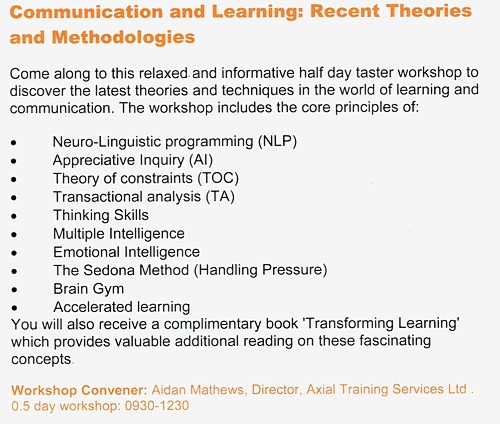
“Self-hypnosis” seems to be nothing more than a pretentious word for relaxation. The person who is teaching researchers to innovate left science straight after his PhD and then did courses in “neurolinguistic programming” and life-coaching (the Carole Caplin of academia perhaps?). How that qualifies him to teach scientists to be innovative in research may not be obvious.
The third course teaches, among other things, the “core principles” of neurolinguistic programming, the Sedona method (“Your key to lasting happiness, success, peace and well-being”), and, wait for it, Brain Gym. This booklet arrived within a day or two of Ben
Goldacre’s spectacular demolition of Brain Gym “Nonsense dressed up as neuroscience”
“Brain Gym is a set of perfectly good fun exercise break ideas for kids, which costs a packet and comes attached to a bizarre and entirely bogus pseudoscientific explanatory framework”
“This ridiculousness comes at very great cost, paid for by you, the taxpayer, in thousands of state schools. It is peddled directly to your children by their credulous and apparently moronic teachers”
And now, it seems, peddled to your researchers by your credulous and
moronic HR department.
Neurolinguistic programming is an equally discredited form of psycho-babble, the dubious status of which was highlighted in a Beyerstein’s 1995 review, from Simon Fraser University.
“ Pop-psychology. The human potential movement and the fringe areas of psychotherapy also harbor a number of other scientifically questionable panaceas. Among these are Scientology, Neurolinguistic Programming, Re-birthing and Primal Scream Therapy which have never provided a scientifically acceptable rationale or evidence to support their therapeutic claims.”
The intellectual standards for many of the training courses that are inflicted on young researchers seem to be roughly on a par with the self-help pages of a downmarket women’s magazine. It is the Norman Vincent Peale approach to education. Uhuh, sorry, not education, but training. Michael O’Donnell defined Education as “Elitist activity. Cost ineffective. Unpopular with Grey Suits . Now largely replaced by Training .”
In the UK most good universities have stayed fairly free of quackery (the exceptions being the sixteen post-1992 universities that give BSc degrees in things like homeopathy). But now it is creeping in though the back door of credulous HR departments. Admittedly UCL Hospitals Trust recently advertised for spiritual healers, but that is the NHS not a university. The job specification form for spiritual healers was, it’s true, a pretty good example of the HR box-ticking mentality. You are in as long as you could tick the box to say that you have a “Full National Federation of Spiritual Healer certificate. or a full Reiki Master qualification, and two years post certificate experience”. To the HR mentality, it doesn’t matter a damn if you have a certificate in balderdash, as long as you have the piece of paper. How would they know the difference?
A lot of the pressure for this sort of nonsense comes, sadly, from a government that is obsessed with measuring the unmeasurable. Again, real management people have already worked this out. The management editor of the Guardian, said
“What happens when bad measures drive out good is strikingly described in an article in the current Economic Journal. Investigating the effects of competition in the NHS, Carol Propper and her colleagues made an extraordinary discovery. Under competition, hospitals improved their patient waiting times. At the same time, the death-rate e emergency heart-attack admissions substantially increased.”
Two new government initiatives provide beautiful examples of the HR mentality in action, They are Skills for Health, and the recently-created Complementary and Natural Healthcare Council.(already dubbed OfQuack).
The purpose of the Natural Healthcare Council .seems to be to implement a box-ticking exercise that will have the effect of giving a government stamp of approval to treatments that don’t work. Polly Toynbee summed it up when she wrote about “ Quackery
and superstition – available soon on the NHS “ . The advertisement for its CEO has already appeared, It says that main function of the new body will be to enhance public protection and confidence in the use of complementary therapists. Shouldn’t it be decreasing confidence in quacks, not increasing it? But, disgracefully, they will pay no attention at all to whether the treatments work. And the advertisement refers you to
the Prince of Wales’ Foundation for Integrated Health for more information (hang on, aren’t we supposed to have a constitutional monarchy?).
Skills for Health, or rather that unofficial branch of government, the Prince of Wales’ Foundation, had been busy making ‘competences’ for distant healing, with a helpful bulletted list.
“This workforce competence is applicable to:
- healing in the presence of the client
- distant healing in contact with the client
- distant healing not in contact with the client”
And they have done the same for homeopathy and its kindred delusions. The one thing they never consider is whether they are writing ‘competences’ in talking gobbledygook. When I phoned them to try to find out who was writing this stuff (they wouldn’t say), I made a passing joke about writing competences in talking to trees. The answer came back, in all seriousness,
“You’d have to talk to LANTRA, the land-based organisation for that”,
“LANTRA which is the sector council for the land-based industries uh, sector, not with us sorry . . . areas such as horticulture etc.”.
Anyone for competences in sense of humour studies?
The “unrepentant capitalist” Luke Johnson, in the FT, said
“I have radically downsized HR in several companies I have run, and business has gone all the better for it.”
Now there’s a thought.
The follow-up
The provost’s newletter for 24th June 2008 could just be a delayed reaction to this piece? For no obvious reason, it starts thus.
“(1) what’s management about?
Human resources often gets a bad name in universities, because as academics we seem to sense instinctively that management isn’t for us. We are autonomous lone scholars who work hours well beyond those expected, inspired more by intellectual curiosity than by objectives and targets. Yet a world-class institution like UCL obviously requires high quality management, a theme that I reflect on whenever I chair the Human Resources Policy Committee, or speak at one of the regular meetings to welcome new staff to UCL. The competition is tough, and resources are scarce, so they need to be efficiently used. The drive for better management isn’t simply a preoccupation of some distant UCL bureaucracy, but an important responsibility for all of us. UCL is a single institution, not a series of fiefdoms; each of us contributes to the academic mission and good management permeates everything we do. I despair at times when quite unnecessary functional breakdowns are brought to my attention, sometimes even leading to proceedings in the Employment Tribunal, when it is clear that early and professional management could have stopped the rot from setting in years before. UCL has long been a leader in providing all newly appointed heads of department with special training in management, and the results have been impressive. There is, to say the least, a close correlation between high performing departments and the quality of their academic leadership. At its best, the ethos of UCL lies in working hard but also in working smart; in understanding that UCL is a world-class institution and not the place for a comfortable existence free from stretch and challenge; yet also a good place for highly-motivated people who are also smart about getting the work-life balance right.”
I don’t know quite what to make of this. Is it really a defence of the Brain Gym mentality?
Of course everyone wants good management. That’s obvious, and we really don’t need a condescending lecture about it. The interesting question is whether we are getting it.
There is nothing one can really object to in this lecture, apart from the stunning post hoc ergo propter hoc fallacy implicit in “UCL has long been a leader in providing all newly appointed heads of department with special training in management, and the results have been impressive.”. That’s worthy of a nutritional therapist.
Before I started writing this response at 08.25 I had already got an email from a talented and hard-working senior postdoc. “Let’s start our beautiful working day with this charging thought of the week:”.
He was obviously rather insulted at the suggestion that it was necessary to lecture academics with words like ” not the place for a comfortable existence free from stretch and challenge; yet also a good place for highly-motivated people who are also smart about getting the work-life balance right.”. I suppose nobody had thought of that until HR wrote it down in a “competence”?
To provoke this sort of reaction in our most talented young scientists could, arguably, be regarded as unfortunate.
I don’t blame the postdoc for feeling a bit insulted by this little homily.
So do I.
Now back to science.
In a wonderful demonstration of common sense, the BBC has removed all the alternative medicine pages from BBC Health web site. I expect that it was helped in making that decision by the many complaints it had received about statements on these pages that were simply not true, The existence of these pages was just not compatible with the BBC’s commitment to accuracy.
| Needless to say, this decision was greeted with howls of rage from the alternative world. Some wrote to the BBC to complain (and I wrote to congratulate them). Until today I haven’t been able to find any BBC statement on the matter. This one appeared on Healthypages, one of the zaniest sites on the net. Nothing is too barmy for them. This is the picture they used to show how wrong the BBC is |  Picture from Healthypages |
“I do a range of spiritual healing practices and can offer an energetic healing session including techniques from the Order of Melchizedek and about 10 forms of Reiki in exchange for a Theta Healing session.”
And just in case you don’t know about the Melchidezek method, here is a picture of a poster in the window of my local “health food” shop.
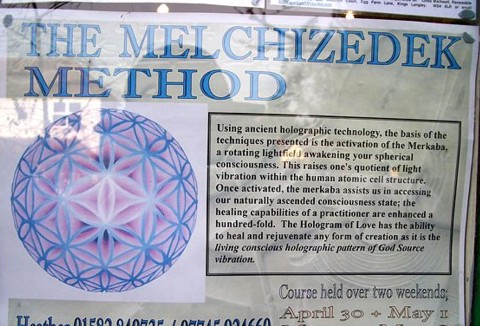
The explanation says
“Using ancient holographic technology, the basis of the techniques presented is the activation of the Merkaba, a rotating lightfield awakening your spherical consciousness. This raises one’s quotient of light vibration within the human atomic cell structure. Once activated. the merkaba assists us in accessing our naturally ascended consciousness state: the healing capabilities are enhanced a hundred-fold. The Hologram of Love has the ability to heal and rejuvenate any form of creation as it is the living conscious holographic pattern of God Source vibration.”
There, and I’ll bet you thought holography was a recent invention. As an example of sciencey-sounding words used in random order, this one takes a bit of beating. It really is an insult to human intellect.
Anyway, back to the BBC. This is their diplomatic response (what they should have said really was, ‘those pages were nonsense so we removed them’).
BBC issued the following statement, dated 22 Feb 2008:
| Complaint We received complaints about the Complementary section of the BBC Health website being disbanded The BBC’s response The decision to remove the complementary medicine area of the health website was taken as part of a wider review of all the health content in order to enable the BBC to focus its efforts on creating new and exciting content. In order to release resources for this redevelopment work, we’re reviewing existing content from an editorial and value-for-money perspective.The complementary health section was incomplete and, therefore, not of a satisfactory editorial standard. It also represented a small proportion of traffic to the site but was disproportionately time-consuming.Therefore, the decision to take it down was based on a combination of factors: how much work it needed to maintain to a high editorial standard, how much this cost and how popular it was with site users.We have already removed other sections of the health site and plan to reduce or remove others. We appreciate people are disappointed this area of the site has been removed and apologise if the decision has appeared abrupt to site users or inconvenienced other sites linking to BBC Health. The BBC will continue to cover complementary health in other areas of its output, such as TV, radio and news programmes, and may reassess its complementary health content in future. |
” . . . However the site has in recent months been targetted by the self-appointed ‘quackbusters’ ( . . . such as David Colquhoun), who sent a deluge of letters and emails claiming that complementary therapies such as homeopathy and cranial osteopathy were ‘unscientific’ and should be removed.”
Well thanks for the credit, but sorry, there was no deluge. I wrote no more than a couple of times myself, and I suspect that a handful of friends did the same. I didn’t even ask them to remove the whole lot, merely to correct particular statements that were not true,
‘Mardi’ goes on
“Rather than taking a reasoned view and considering the evidence from good research studies on complementary medicine, these individuals seem simply hell bent on trying to stamp out complementary medicine”
That really is a bit rich. Suddenly the alternative industry are invoking evidence from good research studies. It is precisely the other way round. It is because that evidence is almost all negative that the BBC have decided to remove their coverage.
Of course it may have helped that the BBC had to spend a lot of time defending itself against criticism of the BBC 2 TV series on Alternative Medicine from February 2006. After initially rejecting complaints, an appeal to the highest level, the Board of Trustees, two of the most serious complaints were upheld against these programmes.
Boots the Chemists have proved themselves dishonest before, over their promotion of homeopathy and of B Vitamins “for vitality”
In a press release dated 12 March 2008, they have hit a new low in ethical standards
| Boots help boost the nation’s energy levels in just one week “Health and beauty expert Boots has launched an exclusive energising vitamin supplement that helps boost depleted energy levels and maintain vitality. It is the first time that this exclusive form of CoQ10 has been made available on the high street.” ” . . .supplementation can help to supply higher levels of CoQ10 than are available in the diet. Boots Energy Super Strength CoQ10 containing natural Kaneka CoQ10 is a way of boosting energy levels that can help people who lack energy to see results in a week” |
You decide.
Last year there was an equally misleading press release about CoQ10 from Solgar/Boots Herbal. That one was headed “Need More Energy – Solgar’s Nutri Nano™ Uses Nanotechnology to Deliver Unprecedented Bioavailability of CoQ10”. Not only is the word ‘energy’ misused but notice that the trendy term ‘nanotechnology’ is worked in for extra sciencey effect. It turns out that all this means is that the preparation contains micelles. So nothing new there either. Micelles have been known for almost 100 years.
In contrast, the Boots online store is noticeably more restrained. Could that be because the Advertising Standards People can’t touch press releases, just as they can’t control what Boots Expert Team tell you face to face in the shop?
Boots PR contact is given as: Carrie Eames, PR Manager, Boots The Chemists, D90W WG14, Thane Road, Nottingham NG90 1BS. I’m not sure how Ms Eames sleeps at night. Perhaps you should write to her and let her know what you think.
You might point out to her Boots (anti) Social Corporate (ir)Responsibility Page. It says
| “So it’s part of our heritage to treat our customers fairly and act with integrity in everything we do, rather than seizing on the quickest and easiest way to turn a profit.” |
CoQ10 and “energy”
Coenzyme Q10 (also known as ubiquinone) is a relatively small molecule. It cooperates with cytochrome enzymes (big proteins) to synthesize a molecule called ATP. This is a chemical form of energy that can be used to do work, such as making a muscle fibre contract.
The word “energy ” here is used in the sense that a physicist would use it. It is measured in joules or in calories. The meaning of the word ‘energy‘ is described nicely in the Wikipedia entry. For example, when an electric current passes through a resistor (like a kettle) the electrical energy is converted to heat energy, and the energy used is potential difference (volts) X current (amps) X time. In other words energy is power (in watts) times time. So another unit for energy is kilowatt-hours (one kilowatt-hour is about 3.6 megajoules).
Energy in this sense has nothing whatsoever to do with the everyday use of ‘energy’ to indicate your vitality, or how lively you feel.
Furthermore there is not the slightest empirical reason to think that CoQ10 makes you feel more lively. None. The press release cites a sciencey-sounding reference (Ernster L, Dallner G. Biochemical, physiological and medical aspects of ubiquinone function. Biochim Biophys Acta. 1995 May 24;1271(1):195-204.). But this paper is just a review of the biochemistry, nothing whatsoever to do with feeling good.
CoQ10 and the supplement business
There is nothing new in this big push by Boots. CoQ10 has been a staple of supplement business for a long time now. All sorts of medical claims have been made for it. Everything from migraine, to Parkinson’s disease to cancer has been raised as possible benefits of the magic drug, oops, I mean ‘supplement’. This is quite improper of course, since it is being sold as a food not as a medicine, but it is standard practice among supplement hucksters, and so far they have been allowed to get away with it.
What’s interesting though is that until Boots PR machine swung into action, one thing that hadn’t been claimed much is that it made you feel more lively. That’s one they just invented.
CoQ10 and the press
It’s standard technique to get free advertising by hoping that journalists will dash off an article on the basis of a press release, with the hope that they will be in too much hurry to check the spin. Too often it works.
The Daily Mail has big coverage of the press release, under the title “Can a 60p pill from the chemist really add years to your life?“. This was written by Anna Hodgekiss and it’s not bad. It starts with a nice note of scepticism
“Forget vitamins C, E or even B12. The real wonder supplement is Coenzyme Q10 or CoQ10. That’s what Boots would have you believe, anyway. ”
“So should we all be taking this supplement?Not according to David Colquhoun, professor of pharmacology at University College London, who says Boots’ claims are “deliberately misleading customers”.
“Yes, CoQ10 helps the body convert glucose into energy, but it’s not the psychological get-up-and-go energy you feel day to day.
“The type of energy it does produce powers our muscles and cells – physical energy. They have confused the two here to promote a product that I’m not convinced would make any difference to how you actually feel at all.”
The article goes on
Among the other sceptics is Scott Marsden, a senior dietician at The London Clinic.
“There haven’t been enough trials to warrant us all taking CoQ10,” he says.
“It sounds boring, but if you are healthy and eating a balanced diet, you will get all the nutrients you need and shouldn’t have to take supplements.
“Not only could you be spending money unnecessarily, you could also be putting your health at risk. Buy some wholesome food instead.” “
Dr Clare Gerada, vice chairman of the Royal College of General Practitioners, is more forthright.
“While there is some evidence to suggest CoQ10 supplements may help patients with heart failure or severe respiratory disorders, more work is needed,” she says.
“This is just another example of normal health being medicalised, and it’s an issue that worries me.
“The human body is an amazing machine, and we have never been in better health. The fact that more people are living well into their 80s and 90s is proof.
“People need to stop looking for a wonder pill in their quest to live for ever.”
But guess who comes out fighting for Boots? None other than my old friend Dr Ann Walker. Little wonder then that my Nutriprofile result recommended a co Q10 supplement, because she is involved in that too.
Ann Walker’s colleague on the Nutriprofile project, Dr Sarah Brewer comments on CoQ10 on the Healthspan site, thus.
“As CoQ10 is vital for energy production in muscle cells, lack of CoQ10 is linked with lack of energy, physical fatigues, muscle aches and pains . . .”
It seems that she also can’t distinguish between energy in joules and energy as vitality,
Female First and Marie Claire also carry a story “Boots Sell ‘Life Extending’ Pill”
“A new pill that claims to add years to our lives is due to hit shelves in Boots stores this week but scientists say the drug is misleading.”
“Despite these claims Professor David Colquhoun told Marie Clare that he believes the drug is ‘deliberately misleading customers’: “Yes, CoQ10 helps the body convert glucose into energy, but it’s not the psychological get-up-and-go energy you feel day to day,” he said.”
(Funny, I never consciously spoke to Marie Claire but the quotation is OK.)
The Times, in contrast, carries an appalling column by their Dr Thomas Stuttaford, “A natural solution to tiredness“. There isn’t even a question mark in the title, and the content is totally uncritical. Private Eye has nicknamed the author ‘Dr Thomas Utterfraud’. How very cruel.
See also, excellent articles on CoQ10 by Ben Goldacre in the Guardian, and at badscience.net, and at Holfordwatch and Dr Aust’s Spleen
Aha Boots have repeated their mendacious claims in newspaper advertisements
This appeared in the Guardian on 18 March, and I’m told it was in the Mail too.

The small print says
“The new Boots Energy supplement contains Kaneka Q10 to help boost your energy levels throughout the day”
Here is what I just sent to the Advertising Standard Authority, or email new.complaints@asa.org.uk . Why not have a go yourself?
| “The words “boost your energy levels” and “still lacking energy” constitute a (presumably deliberate) confusion beteen ‘energy’ measured in joules and the everyday use of the word ‘energy’ to mean vitality. The former usage would be justified in viewof the role of Coenzyme Q10 in ATP production. There is neither theoretical justification nor any empirical evidence that CoQ10 helps your vitality or ‘energy’ in the latter sense.” |
A full size graphic to attach to your complaint can be downloaded here.
We are all interested in the relationship between our health and what we eat. What a pity that so little is known about it.

The problem, of course, is that it almost impossible to do randomised experiments, and quite impossible in most cases to make the experiments blind. Without randomisation there is no way to be sure about causality, and causality is all that matters. All you can do is measure “associations” and that sort of information is simply unreliable.
For example, if you simply observe that people who eat a lot of dark green vegetables are healthier than those who don’t, there is no reliable way to tell whether their health is caused by eating the vegetables. It is just as likely that, for example, rich people are healthier because the are rich, not because they eat more vegetables. The answer, though usually not known, is the only thing that matters for offering advice. The crucial problem is that, in the latter case, it will do no good at all to bully a poor person to eat more vegetables: their health will not improve because their bad health was caused by poverty, not by lack of vegetables.
It is precisely this difficulty that results in the constantly conflicting advice that we are given about diet. I can’t think of any single thing that does more harm to real science than the fact that one week we are told that red wine is bad and the next week we are told that red wine is good. No doubt both statements were based on a naive observational studies, the significance of which is vastly exaggerated by its authors (and often by their university’s media department too).
The first job of a scientist is to be able to say “I don’t know”. Under pressure from the government’s audit culture, and the HR apparatchiks who embrace it so eagerly, all that is forgotten only too easily. he lack of certain answers about diet leaves a vacuum into which not only naive scientists are sucked, but also it is a gift for hucksters who are eager to sell you expensive ‘supplements’, whether or not you need them. As always, it is a case of caveat emptor.
The questions are important to us all, so when sciencepunk pointed out to me a chance to check my own diet, I went for it. I try to keep pretty close to the current guidelines. Unreliable though they may be, they are the best we’ve got. So I went to the Nutriprofile site, and filled in the questionnaire, quite honestly (apart from saying I was 37 -I wish).
I eat plenty of fruit and oily fish every week so I though I’d do quite well. No such luck. I ended up being told I was deficient in iron and selenium, and at “risk of deficiency” in vitamin B5 (pantothenic acid), folate, vitamins D, E, K, magnesium, copper and potassium.
Uhuh, I must really be ill and I’d never realised it.
At the bottom of this analysis of all my deficiencies comes the sales pitch, “your personalised supplement recommendations”.”Strongly recommended” for me is Gold Standard A-Z Multivitamins (just click on the “buy now” button). I’m also “recommended” to buy Omega 3 1000mg capsules.
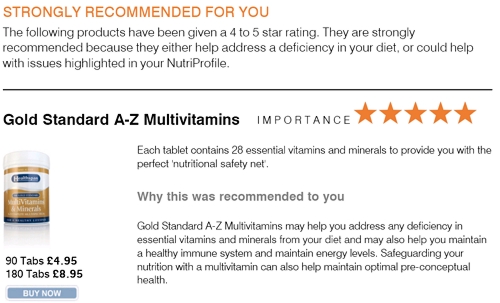
And then I’m invited to consider a whole list of other supplements
“The following products have been given a 1 star rating. This usually means they have been recommended to meet a specific issue raised by your NutriProfile. You should consider these supplements where you feel they could help if the issue is particularly important to you”
Here is the list.
- Selenium + A,C,E,
- Echinacea (“may help you maintain a healthy immune system”).
- OptiFive (antioxidant supplement)
- Co-enzyme Q10 (“may help you maintain energy levels” -look out for a forthcoming post on this scam)
- Memo Plus (“may help you maintain brain health and cognitive function”),
- Panax Ginseng (“may help you to maintain energy levels”
- Psyllium Husks
- Magnesium
- Vitamin D
- Ginkgo Biloba
- Probiotic
As always, there are lots of fantasies about “strengthening the immune system”. And the great antioxidant myth is exploited to the full.
Puzzled by this result, I got my wife to do the questionnaire, and also a particularly healthy and diet conscious colleague.
My wife was recommended to buy Omega 3 1000mg, Osteo Plus Bone health supplement (despite telling them that she already took calcium) and 50 Plus Multivitamins (“may help you address any deficiency in essential vitamins and minerals and may also help you maintain a healthy immune system and maintain energy levels. “). And then it may not.
My spectacularly healthy and diet conscious colleague got a strongly recommended (maximum 5 stars like me) for Gold Standard A-Z Multivitamins and for Omega 3 1000mg, as well as “recommended” for plant sterols, garlic and Opti-Omega 3.
Either I’m a lot unhealthier than I thought, or Nutriprofile is a sales scam.
You decide.
Is there anyone at all who does NOT need supplements?
By this stage I was getting suspicious so I sent the link to a professional dietitian, Catherine Collins of St George’s Hospital London. Unlike the people running the site, she has no financial interest in selling you pills. I asked her to fill in the questionnaire as a hypothetical person who had an ideal diet, based on current nutritional knowledge . Surely such a paragon of dietetic virtue would not need to buy pills too?
Don’t you believe it. At least she didn’t get any 5 star “strongly recommended”, but she did get “Recommended for you” Opti-Omega 3 (3.5 stars) and Gold Standard A-Z Multivitamins (3 stars). Plus, of course the whole list of “you may like to consider”, same as everyone seems to get.
So I asked Collins how it came about that everyone seems to end up being recommended to buy pills after going through all the questions. Here is what she said.
“Apparently my ratio of omega3:6 is unbalanced. not if you ate the amount of oily fish i’d put in, and used ‘vegetable’ oil which is mono-rich rapeseed. I think they’ve used the sunflower analysis to generate this distortion.
I disagree with absolute amounts of omega-3 per day. The amount I recorded meant I would easily exceed a daily intake of 500 mg of the important omega-3 fats, EPA and DHA
Low Vitamin B6 and folate – totally incorrect recommendation based on my entries
Potassium – the survey indicated concern that diet provided 200mg per day less potassium than recommended. This was incorrect, the flaw I assume being due to inability of the questionnaire to handle portion sizes. Should I have been worried even if this had been accurate? Of course not. Potassium is widespread across food groups, the most concentrated being fruit and vegetables. It is an essential nutrient, but its requirements are relative to sodium (‘salt’) intake.
Their omega-3 fat recommendation is double the FSA/ SACN suggestion of 450mg/d – they actually quote this in their supporting information but then say ‘experts say we need double’ [their experts are below]. This is highly misleading. We need a combination of omega-3 fats in our diet for health – not only the ‘fishy’ EPA and DHA, but also the readily available ALA, found in vegetable (rapeseed) oil
Omega 3:6 ratio -completely wrong based on the foods entered. Demonstrates a major flaws in the assumptions made about type and amount of foods in the diet.
Water recommendations. Totally inaccurate information based on the myth expounded by the health food industry and its workers that caffeine is a diuretic. This been extensively researched and proven to be not true ( Grandjeans excellent work). The only way in which a caffeinated beverage is ‘diuretic’ to someone who takes caffeinated drinks regularly is in the volume of drink consumed.
She concludes
“”This appears an elaborate pill-pushing exercise. Superficially reassuring in promoting the recognised FSA (Food Standards Agency] line – but then giving undue – and unjustifiable – support to the anecdotal ‘experts recommend’ to create what will be a powerful sell”
The comment about water intake stems from this bit of Collins’ Nutriprofile:
“Caffeinated drinks, fizzy drinks and alcohol do not count because, whilst they contain water, they are mild diuretics, ie. they boost urine output and therefore should only form a small part of your total fluid intake.”
This myth (aka nutribollocks) is quite contrary to what the real research (going back to 1928) says, Check “Laying the caffeine myth to rest” for the real story..
I’m told that Healthspan are now sending out the paper questionnaire in newspapers. Presumably this is to ensure that the poor, the elderly etc and others who that aren’t computer literate don’t miss their buying opportunity. How considerate of them.
Nutriprofile’s expert team
Who is the expert team behind Nutriprofile? Here they are.
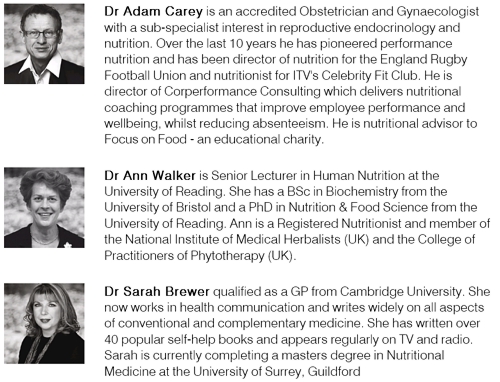
 |
 |
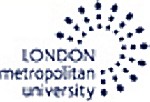 |
What do the real experts say about supplements?
The story you get is quite different when you ask somebody who is not trying to sell you something
The Food Standards Agency says
“Most people should be able to get all the nutrients they need by eating a varied and balanced diet. But if you choose to take supplements, it’s important to know that taking too much or taking them for too long can cause harmful effects.”
Harvard Men’s Health Watch says
“Harvard Men’s Health Watch suggests that the average man give up the multivitamin, at least until scientists solve the puzzle of folic acid and cancer.”
“If you eat a balanced diet that includes food from all the major groups, there should be no need to take vitamin supplements. The food you eat will provide you with all the vitamins and minerals you need. “
I guess we should not be surprised at the direct contradiction between this advice and that of the Nutriprofile questionnaire. After all, Nutriprofile was developed by a company, Healthspan, that is devoted to selling “supplements” with all the dubious claims and customer testimonials associated with the alternative health industry.
But this is what always happens when big business controls science.
Postscript
Oddly enough, Ann Walker’s experience seems to be much the same as ours. In an interview on the Healthspan site we read this.
Q: Which nutritional supplements do you choose to take?
A: I regularly take a multivitamin, vitamins C and E, fish oil, and a calcium and magnesium combination. I also take vitamin D during the winter and some herbs as and when they are needed.
Even if I have improved my diet, each time I complete the NutriProfile questionnaire my requirement for a multivitamin, calcium and magnesium, and a fish oil supplement are always thrown up.
Didn’t it occur to her to wonder why?
The sales pitch was followed up on 27 March the email arrived from Healthspan “Healthspan are offering you £5 to spend towards your recommended supplements”. One can’t say whether this offer goes to people who were not recommended supplements, because so far no such person has been found.
This afternoon I went to the Coliseum to see a revival of Jonathan Miller’s 1986 production of the Mikado. It was beautifully staged. The well-known patter song of Ko-Ko, the Lord High Executioner of Japan, begged for a version that deals with anti-science (original here). The serious post will come later. Meanwhile here’s some late night rhyming.
Ko-Ko
As some day it may happen that a victim must be found,
I’ve got a little list — I’ve got a little list
Of society offenders who might well be underground,
And who never would be missed — who never would be missed!
There’s the pestilential bureaucrats who want to send you on a course —
The HR folks who treat you not as human but as mere resource
Skills specialists who think that education just means training
And all ex-scientists who used to work, but now are only feigning
They’d none of ’em be missed — they’d none of ’em be missed!
Chorus.
He’s got ’em on the list — he’s got ’em on the list;
And they’ll none of ’em be missed — they’ll none of ’em be missed.
Ko-Ko
And that deluded nuisance, whom no one understands
The homeopathist – I’ve got her on the list!
All Reiki folks, pill hucksters and layers on of hands
They’d none of ’em be missed — they’d none of ’em be missed.
And herbalists and Princes who like to talk to trees
Those phony nutritionists who’ll treat you for large fees
And that singular anomaly, the acupuncturist —
I don’t think they’d be missed — I’m sure they’d not be missed!
Chorus.
You may put ’em on the list — you may put ’em on the list;
And they’ll none of ’em be missed — they’ll none of ’em be missed!
Ko-Ko
There’s the vision statement writer, and others of that sort
And the crystal therapist — I’ve got him on the list!
And the people who think long words are a substitute for thought
They never would be missed — they never would be missed!
Then those whose knight starvation makes them crave the honours list
So all below must suffer in case their chance is missed
And those who think that science can be judged by its citations
And so kill creativity by funding only applications
But it really doesn’t matter whom you put upon the list,
For they’d none of ’em be missed — they’d none of ’em be missed!
Chorus
You may put ’em on the list — you may put ’em on the list;
And they’ll none of ’em be missed — they’ll none of ’em be missed!
Postscript
I replaced two lines after my pedantic sister pointed out their imperfect rhyme and scansion. Personally I’m with Charles Babbage.
Here is letter that Babbage is said to have written to Tennyson after reading “The vision of sin”.
In your otherwise beautiful poem there is a verse that reads:
“Every moment dies a man
Every moment one is born”It must be manifest that, were this true, the population of the world would be at a standstill. In truth the rate of birth is slightly in excess of that of death. I would suggest that in the next edition of your poem you have it read:
“Every moment dies a man
Every moment 1 1/16 is born”Strictly speaking this is not correct. The actual figure is a decimal so long that I cannot get it in the line, but I believe that 1 1/16 will be sufficiently accurate for poetry.
I am etc,
(The Mathematical Gazette, 1927, p270)
This is the third post based on a recent trip to North America (here are the first and second)
One aspect of the endarkenment, the Wal-Mart model of a university, is very much the same in the US as in the UK. At one US university, an excellent scientist offered the theory that an alien spacecraft had scattered spores across the land which developed into HR staff who appeared at first sight to be human, and who colonised academia.
The penetration of quackademics into US universities is a bit different from in the UK.
In the UK, the plague is restricted to sixteen or so ex-polytechnic universities which, to their great shame, actually offer Bachelor of Science degress in subjects like homeopathy. There are bits of quackery in good teaching hospitals (such as laying-on-of-hands at UCLH), but not very much.
In the USA and Canada, this sort of “vocational” training does not occur much in universities, but in separate colleges. The situation is worse there though, insofar as these colleges have been allowed to award titles like ‘doctor of naturopathic medicine (ND)’, for work that in no respect compares with what the rest of the world has to do to earn a doctorate. This prostitution of academic titles has not happened to anything like the same extent in the UK. How our own quacks would love it if they were allowed to call themselves ‘doctor’ and sport the initials ND (so easily mistaken for MD at first sight).
It is on the clinical side where the situation is far worse than in the UK. Almost every university hospital, including Harvard, Yale and Stanford, has departments devoted to fairy-tale medicine.
Quacks use a number of euphemisms to make themselves sound more respectable. First they became ‘alternative medicine’, then ‘complementary medicine’. Now the most-used euphemism is ‘integrative medicine’, which is favoured by most US universities (as well as by the Prince of Wales). Raymond Tallis pointed out that this seems to mean integration of treatments that don’t work with treatments that do work.
An official roll of shame for North American universities can be seen here (35 in USA and 4 in Canada). 
A bigger collection of 44 universities has been posted by the incomparable Orac at the The Academic Woo Aggregator. He’s had good support in the USA from DrRW (R.W. Donnell), see particularly his articles on How did pseudoscience get admitted to medical school? and What is happening to our medical schools? Abraham Flexner is turning over in his grave.
All these outfits have two things in common. They all claim to be scientific and evidence-based, and none has produced any real evidence that any of their treatments work.
Here are a few examples of what’s going on.
Yale University School of Medicine

The usual theme is expressed thus.
“Through open-minded exploration and rigorous scientific inquiry, we aim to improve awareness and access to the best in evidence-based, comprehensive medical care available worldwide, with the goal of optimizing health and healing for patients”
The driving force behind the woo seems to be a fourth year medical student, Rachel Friedman, so I wrote to her to ask what useful alternative treatments had been established by research at Yale. But she could not identify any. All I got was this.
“My best advice would be to do some medline searching of metaanalyses” there’s been enough research into some of these modalities to provide for a metaanalysis.”
So she was unable to produce nothing (and anyway. metanalyses, useful though they may be, are not research).. A glance at the Yale publications page shows why.
The Scripps Institute
![]()
Scripps Center for Integrative Medicine says
“In use at Scripps since 1993, Healing Touch is an energy-based, non-invasive treatment that restores and balances energy to help decrease pain and relieve associated anxiety.
Healing Touch is performed by registered nurses who recognize, manipulate and balance the electromagnetic fields surrounding the human body, thereby promoting healing and the well-being of body, mind and spirit.”
“Balances energy”?
“manipulate and balance the electromagnetic fields surrounding the human body”?
This is just meaningless baloney. And it come from the Scripps Institute.
The Oregon Health & Science University
![]()
![]()
OHSU is an excellent and well-respected research university where I have many friends. It was a pleasure to meet them recently.
But it also has a big department of “Complementary and alternative medicine” and an “Integrated medicine service”. There are some good bits of advice mixed up with a whole range of crazy stuff. Take their page on homeopathy.
“This therapy treats ailments with very small amounts of the same substance that causes the patient’s symptoms.”
WRONG. In most cases it is zero amount. To brush this fact under the carpet is simply dishonest (and perhaps a sign of guilt). Then comes this (my emphasis)..
Explanations for why homeopathy works range from the idea that homeopathic medicine stimulates the body’s own natural defenses to the idea that homeopathic medicine retains a “memory” of the original substance.
However, there is no factual explanation for why homeopathy works and more research is needed.”
WRONG. This statement carries (twice) the expicit message that homeopathy does work, quite contrary to a mountain of good evidence that it is merely a placebo. The statement is deceptive and dishonest. And it comes with the OHSU logo.
The University of Arizona

” Heal medicine”, “Transform the world?” Modest uh?
The University of Arizona Program in Integrative Medicine is certainly not modest in its claims, but its publications page shows that it doesn’t even attempt to find out if its “therapies” actually work.
Here is an example. They are advertising their Nutrition and Health conference
heavily.

There’s nothing wrong with good nutrition of course, but the ‘alternative’ approach is instantly revealed by the heavy reliance on the great antioxidant myth.
And look at the sponsors. The logo at the top is for Pistachio Health, a company that promotes pistachio nuts: “Delicious and good-for-you, pistachios are nature’s super heart-healthy snack. Nutrient dense, full of fiber and antioxidants, pistachios give you more bang per calories than any other nut.”.
The other advertisement is ‘POM Wonderful’, a company that sells and promotes pomegranate juice, “POM is the only pomegranate juice you can trust for real pomegranate health benefits”
No doubt pistachio nuts and pomegranate juice are perfectly good foods. But the health claims made for them are just marketing and have very little basis in fact.
Now let’s look at the speakers. Take, for example, Dr David Heber, MD., PhD. He is director of the UCLA Center for Human Nutrition at the University of California, Los Angeles, a professor of Medicine and Public Health, and the founding Chief of the Division of Clinical Nutrition in the Department of Medicine. He is the author of several books including “What Color is Your Diet” and the “L.A. Shape Diet.” With the possible exception of the books, you can’t sound like a more respectable and impartial source of advice than that.
But hang on. Dr Heber is to be seen in a video on the Pistachio Health web site doing what amounts to a commercial for pistachio nuts.
OK let’s take a look at one of Dr Heber’s papers. Here’s one about, guess what, pomegranate juice. “Pomegranate Juice Ellagitannin Metabolites Are Present in Human Plasma and Some Persist in Urine for Up to 48 Hours”. The work was “Supported by the Stewart and Lynda Resnick Revocable Trust and from the NIH/NCI grant P50AT00151”. So no problems there. Well not until you check POM Wonderful in Wikipedia, where you find out that Stewart and Lynda Resnick just happen to be founders of POM.
Of course none of these interesting facts proves that there is anything wrong with the work. But they certainly do show that the alternative nutrition business is at least as much hand-in-glove with big business as any other form of medicine. And we know the problems that that has caused.
So, if you want impartial advice on nutrition, sign up for the 6th Annual Nutrition and Health meeting. For “MD, DO, ND & other doctors”, it will cost you only $845 to register .
The meeting is being run by The University of Arizona College of Medicine and Columbia University’s College of Physicians and Surgeons.

![]()
The University of Arizona is, incidentally, also the home of the famous (or perhaps infamous) Gary Schwartz (see also, here). He “photographs” non-existent “energy fields” and claims to be able to communicate with the dead, and he is director of its Human Energy Systems Laboratory at the University of Arizona. He is also head of the inappropriately-named Veritas Research Program and “Centre for Frontier Medicine in Biofield Science”. All of these activities make homeopathy look sane, but he is nevertheless part of an otherwise respectable university. In fact he is He is Gary E. Schwartz, Ph.D. is professor of psychology, medicine, neurology, psychiatry and surgery at the University of Arizona. Even more incredibly, this gets NIH funding.
Columbia University, along with Cornell, also has its own “Complementary, alternative, and integrative medicine“, defined as “the use of treatments, such as homeopathic medicine, ayurveda, botanical dietary supplements”. And their “Integrative Therapies Program for Children” is intimately tied up with a company called Origins, which is more a cosmetics company, Origins” (with all the mendacity that implies). They say
“Origins understands the importance of addressing wellness through an integrative approach,” says Daria Myers, President of Origins Natural Resources. “With our recent Dr. Andrew Weil collaboration, Origins demonstrated its support for the integrative wellness concept. Now, with the introduction of the new Nourishing oil for body and massage, we hope to bring not only a moment of comfort but also a healthy future to children enduring the fight of their life.”
Andrew Weil is, of course, the promoter of the Arizona meeting.
The corruption of Universities by this sort of activity is truly amazing.
Thursday 24 Jan.
One of the original reasons for going to North America was an invitation from the Toronto Secular Alliance and Center for Inquiry. The talk for them was given a lot of publicity, for example here and here and from the totally admirable Orac.
Toronto seems to be no worse than anywhere else when it comes to delusional thinking about medicine. It is, of course, the home of Ryerson University, the place that produced one of the most outrageous pieces of postmodernist nonsense on record. But when this sort of thing gets into really good universities, it is more worrying.
As a result of the publicity there was some media coverage (and a record 7109 hits on this site on Sunday).
 |
Friday 25th January, Reception and talk: Center for Inquiry. Science in an Age of Endarkenment: Some Examples from Scientific Fraud, Quackery, Religion and University Politics |
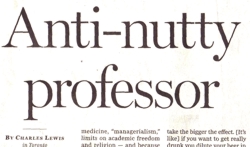 |
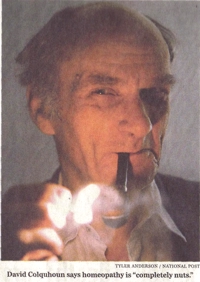 |
 |
The interview was broadcast on Sunday morning (28 Jan) and elicited a lot of correspondence. CBC made it available as a podcast which can be downloaded from CBC here. The endarkenment interview was the last 22 minutes (out of 64 minutes) [play the interview here (mp3, 20 Mb)]. |
Sunday Edition: the follow-upThe week following this CBC show, the backlash started. The Sunday Edition wrote
“A stirred-up hornet’s nest is a mild disturbance compared to the firestorm we unleashed last week over my conversation with Dr. David Colquhoun. Dr. Colquhuon [sic] is a gangly, pipe-puffing British pharmacologist who thinks all alternative medicine, all of it, is a fraud perpetrated by quacks. But he went further, somehow suggesting that those who believe in it probably supported Margaret Thatcher, Ronald Reagan and the Ayatollah Khomeini. He pooh-poohed acupuncture, chiropractic, homeopathy, even vitamins.
Well, his remarks opened the floodgates of listener mail, screaming for Dr. Colquhoun’s head on a pike. In a few moments, alternative or complimentary [sic] medicine strikes back. With the help of two experts, we will try to give the other side of contentious Colquhounism.”
The programme for 3 Feb 2008 started with a few emails from listeners, mainly of the “homeopathy cured my granny” type. Nothing of much significance there. But then Enright interviewed Dugald Seely of the Canadian College of Naturopathic Medicine and Dr. Kien Trinh of the DeGroote School of medicine at McMaster University in Hamilton. You can download the podcast here.
The flat earth problem.
Michael Enright was a good interviewer, but Sunday Edition suffers, like the BBC, from a problem. It is admirable that CBC, like the BBC, should strive to be ‘fair and balanced’, but it is not always easy to see what that means in practice. Is it fair and balanced to give equal time to people who think that the earth is flat and those who think it is spherical (OK, an oblate ellipsoid)? Perhaps, but it also
quite misleading because it can easily convey a very distorted idea of the balance of informed opinion. In this case the flat-earthers are the homeopaths and other alternative medicine advocates. That would not matter so much if the interviewers had enough knowledge of the subject to pin down the falt-earth advocates with the sort of penetrating questions that people like John Humphrys (of the BBC’s Today programme) are so very good at. When it comes to science, though, the flat-earthers tend to get away with murder, and the public can easily be left with a very distorted view. Which “expert” should they believe? If I had been given the option, I would have loved to debate the problems of alternative medicine directly with Trinh and Seely I could have asked then a few questions that Enright missed.
Let’s take a look at what happened at the follow-up.
Quackery at McMaster University
McMaster is one of many universities in North America that has chosen to betray the intellectual tradition of the enlightenment by buying into superstition (see the roll of shame here). The ‘contemporary medical acupuncture program appears to run under the aegis of the anaesthesia
department, though the fact that is doen’t appear on the department’s front page suggests there may be some embarrassment about it. The medical acupuncture program itself, has separate web pages which don’t seem to be on the McMaster server at all (they are on a private server, ThePlanet.com Internet Services, Inc.
As so often, these pages pay lip service to an ‘evidence based’ or ‘scientific’ approach, while doing nothing of the sort. In his CBC interview Kien Trinh agreed (twice) with my contention that trials had shown that it doesn’t matter where you put the needles. But then he failed totally to draw the obvious conclusion that ‘meridians’ are mumbo jumbo. He went right on taking the conventional mystical view of meridians and “energy” flow. Like most proponents of alternative medicine, Trinh seems to live in some sort of parallel universe in which the normal rules of logic don’t apply.
On wouldn’t expect regular anaesthetists to accept this sort of mystical nonsense, but it seems one would be wrong. When I wrote to the Chair of the Department of Anesthesia, at McMaster to ask about their relationship with acupuncturists there was no hint of embarrassement. Dr Norman Buckley, BA (Psych), MD, FRCPC, wrote
“It operates under the principles of evidence based medicine, and relates the concepts raised by the Acupuncture/traditional Chinese medicine to physiology anatomy et as it is more usually taught in Western schools.”
That would be all very well if it were true, but it simply isn’t true. The evidence just isn’t there, and the departments involved make no serious attempts to get evidence. In a later letter, Dr Buckley seems to acknowledge that it may be all placebo, but seems reluctant to offend anyone by saying so. That, I suspect, is how quackery has gained such a foothold.
It is good to keep an open mind, but if it is too open your brains fall out. Or, in another variant, if it is too open, someone will fill it with trash.
One looks in vain on Trinh’s web site for any good evidence. They quote approvingly the conclusion of a 1997 NIH Consensus statement that says “There is sufficient evidence of acupuncture’s value to expand its use into conventional medicine and to encourage further studies of its physiology and clinical value.”, but forget to mention that this document is headed “This statement is more than five years old and is provided solely for historical purposes.”. The department doesn’t seem to do much original research, just to write endless reviews of other peoples’ work. The reviews aren’t too bad, and mostly they come to the right conclusion, that there is not enough evidence to come to firm conclusions. The difference from science is that this doesn’t dent their confidence for a moment. A typical sort of conclusion seems to be
Elbow pain. A review by Green et al. concluded “needle acupuncture [is] of short-term benefit with respect to pain, but this finding [is] based on the results of two small trials, the results of which [are] not able to be combined in metaanalysis.”
The results of thousands of years experience with acupuncture seem to be pretty pathetic so far..
Quackery at the Canadian College of Naturopathic Medicine (CCNM)
Unlike McMaster, CCNM isn’t a proper university, though nonetheless is hands out ‘doctorates’. Dugald Seely’s contribution was interesting insofar as he admitted that there was a lot of fraud and unjustified claims in the alternative medicine industry (never forget there are megabucks involved). What he didn’t explain was how he himself could be distinguished from the frauds. The problem, as always is the second-rate research that goes on in this area.
Take one of Seely’s papers, Adaptogenic Potential of a Polyherbal Natural Health Product: Report
on a Longitudinal Clinical Trial. Is only too typical: a small non-randomised, open-label (not blind) “trial” of a complex herbal mixture on 17 patients. The conclusion was, as it almost always is,
“Further research using a randomized controlled design is necessary to confirm the findings from this pilot study.”
In other words, no conclusion at all. Why is it that the proper trial never seems to appear? Could it be that naturopaths, and the wealthy industry behind them, are afraid to do proper trials? That is certainly the impression they give.
One way in which the alternative medicine industry operates is to invent new words with ill-defined meanings (and Big Pharma does it too). In case you were wondering about the word “adaptogen” it is defined as “Essentially the adaptogen supports the body’s ability to ‘adapt’ ideally to its environment. Essentially the adaptogen supports the body’s ability to ‘adapt’ ideally to its environment. ”
Whatever that means.
The Canadian College of Naturopathic Medicine offers the following “therapies”.
- acupuncture/Asian medicine
- botanical medicine
- physical medicine (massage, hydrotherapy, etc.)
- clinical nutrition
- homeopathic medicine
- lifestyle counseling
Well, nothing wrong with nutrition and lifestyle counseling as long as the claims aren’t exaggerated. But, as always, the claims that are made are vastly exaggerated. For example they claim
Homeopathic remedies are particularly effective for:
- depression
- anxiety
- allergies
- infections
- gynecological concerns
- skin conditions
- digestive problems
- chronic and acute conditions including colds and flu
These claims are simply not true, in my view. If you don’t believe me, check NELCAM (the NHS Complementary and Alternative Medicine Specialist Library). This is written by advocates of alternative medicine, yet it finds no convincing evidence for effectiveness of homeopathy in any of the conditions listed above.
Or, even more remarkably, from a report in Newsweek.
“Dr. Jack Killen, acting deputy director of the National Center for Complementary and Alternative Medicine, says homeopathy “goes beyond current understanding of chemistry and physics.” He adds: “There is, to my knowledge, no condition for which homeopathy has been proven to be an effective treatment.”
The National Center for Complementary and Alternative Medicine (NCCAM) has, incidentally, spent almost one billion US$ billion of US taxpayers’ money and has come up with next-to-nothing useful.
So the claims made by the Canadian College of Naturopathic Medicine are not backed up even by people who are directly involved in alternative medicine You don’t have to be a rocket scientist to understand that the medicine contains no medicine.
| “the report is more hypothesis-generating for future research than a rigorous scientific study. Find us some money and we will do a proper job. You can quote me for that.” Professor David Smith (Oxford). Scientific adviser for Food for the Brain. |
For a quick synopsis, look at Holfordmyths.org.
Patrick Holford and Drew Fobbester are joint researchers and authors of the Food for the Brain Child Survey , September 2007 (pdf). Holfordwatch has made a very thorough study of this report, in eight parts (so far). They conclude
“HolfordWatch can not share the optimism for these claimed benefits and finds that there is insufficient data to support them in a robust manner.”
There are many detailed questions, but the basic problem with the report is very simple. The fact that is (a) self-selected and (b) not randomised make it just another naive observational study. The stunningly obvious confounder in this case is, as so often, the socio-economic background of the kids. That was not even assessed, never mind any attempt being made to allow for it.
This isn’t just pedantry because what matters is causality. It is worth very little to know that eating vegetables is correlated with high SAT score if the correlation is a result of having well-off parents. If that were the reason, then forcing kids with poor parents to eat vegetables would make no difference to their SAT score because their parents would still be poor. The only conclusion of the study seems to be that we should eat more fruit and vegetables, something that we are already lectured about in every waking moment.
Many questions about the report have not yet been answered by its authors. But the report has a panel of scientific advisors, some of whom at least seem to be very respectable (though not ‘orthomolecular medicine‘, which is a cult founded on the batty late-life beliefs of the once great Linus Pauling that Vitamin C is a magic bullet).

Furthermore they are thanked thus
![]()
As it happens, David Smith is an old friend, so I wrote to him, and also to Philip Cowen, with some detailed questions. I didn’t get detailed answers, but the responses were none the less interesting. Cowen said
“I did see the report and quite agree with your conclusions that it an observational study and therefore not informative about causality.”
“The advice about diet seems reasonable although, as you point out, probably somewhat redundant.”
But still more interesting, David Smith told me (my emphasis)
“the survey was the largest of its kind and was done on minimal funding; hence several matters could not be dealt with and so the report is more hypothesis-generating for future research than a rigorous scientific study. Find us some money and we will do a proper job. You can quote me for that, if you wish.”
I’d grateful to David for his permission to quote this comment, It seems that Holford’s top scientific advisor agrees that it is not a rigorous study, and even agrees that the “proper job” is still to be done.
But it does seem a shame that that was not made clear in the report itself.
As I have often said, you don’t need to be a scientist to see that most alternative medicine is bunk, though it is bunk that is supported and propagated by an enormously wealthy industry..
There were two good examples this week, John Sutherland, who was until recently professor of English literature at UCL, understands it very well. And so does political columnist, Polly Toynbee.
“Complementary and Natural Healthcare Council”
Polly Toynbee’s column, “Quackery and superstition – available soon on the NHS“, was prompted by the announcement in The Times that the government was to set up a “Natural Healthcare Council”. It was soon renamed the “Complementary and Natural Healthcare Council” (CNHC) It was instantly dubbed ‘OfQuack’ in an admirable analysis by quackometer.a>
The very name is tendentious and offensive to any thinking person. What is “natural” about sticking needles in yourself, or taking homeopathic polonium?
Toynbee comments
“Put not your trust in princes, especially not princes who talk to plants. But that’s what the government has decided to do. The Department of Health has funded the Prince of Wales Foundation for Integrated Healthcare to set up the Natural Healthcare Council to regulate 12 alternative therapies, such as aromatherapy, reflexology and homeopathy. Modelled on the General Medical Council, it has the power to strike therapists off for malpractice.”
There was only one thing wrong in this article. Toynbee says
“The alternative lobby replies that conventional medicine can also do more harm than good. They chortle with glee at an article in the Lancet suggesting there is no scientific evidence for the efficacy of 46% of conventional NHS treatments. But that’s no reason to encourage more of it.”
Professor John Garrow has pointed out (see, also Healthwatch )
“It is true they chortle, but they have got their facts wrong. The 46% of treatments which are not proven to be effective is 46% of all treatments for 240 common conditions – and very few are used in the NHS. The great majority are treatments used by alternative practitioners. “
The unconstitutional interference by the Prince of Wales in public affairs has been noted often before, and it seems that it’s happening again.
For example, there is the TV programme, “Charles, the Meddling Prince”, or, for a US view, see “Homeopathy: Holmes, Hogwarts, and the Prince of Wales“. And then there’s Michael Baum’s superb “An open letter to the Prince of Wales: with respect, your highness, you’ve got it wrong“.
It isn’t that regulation isn’t needed, but that the sort of regulation being proposed won’t do the trick. The framework for the “Natural Healthcare Council” has been set up by Professor Dame Joan Higgins, and it seems to be very much along the lines proposed by the Prince of Wales. Here’s what’s wrong.
| Professor Dame Joan Higgins (Jan 10th) says “Complementary therapists have been in practice for many years” and “If complementary therapy is not to be banned, is it not, therefore, wise to regulate it and offer the public some measure of protection”. That’s fine, but I think the sort of regulation that she, and the Prince of Wales, are proposing won’t do the trick. We don’t need new laws, or new quangos, just the even-handed application of existing laws. Homeopathic arnica 30C contains no arnica, and one would expect that the Office of Fair Trading would have banned it. It is no different from selling strawberry jam that contains no strawberries. But absurd legal loopholes make homeopaths immune to prosecution for this obvious mislabeling, whereas jam fraudsters would be in deep trouble. The Advertising Standards Authority, likewise, is prevented from doing its job by legal loopholes, and by the fact that it has no jurisdiction over web advertising, which is now the main source of untrue claims. If alternative medicine advocates had to obey the same laws as the rest of us, the public would be better protected from fraud and delusion. What won’t work is to insist that homeopaths are “properly trained”. If one takes the view that medicines that contain no medicine can’t work, then years of being trained to say that they do work, and years spent memorizing the early 19th century mumbo-jumbo of homeopathy, does not protect the public, it imperils them. |
The “Natural Healthcare Council” isn’t the only example either. Try Skills for Health.
Skills for Health
This appears to be a vast bureaucratic enterprise devoted to HR-style box-ticking. Just in case you don’t know about this latest bit of HR jargon, there is a flash movie that explains all.
“Competences are descriptors of the performance criteria, knowledge and understanding that are required to undertake work activities. They describe what individuals need to do, and to know, to carry out the activity -regardless of who performs it.”
That sounds OK until you realise that no attention whatsoever is paid to the little problem of whether the “knowledge and understanding” are pure gobbledygook or not. It’s rather like the HR form that ensures UCLH that you are a fully-qualified spiritual healer “Laying on of hands: just tick the box“.
It is an invidious insult to human intelligence to suppose that exercises like this are an appropriate way to select people for jobs. They have precisely the opposite effect to that intended.
An indication of the level of their critical thinking is provided what is written about the 62 items listed under “Complementary Medicine” These include “CHH5 Provide Healing”.
“This workforce competence is applicable to:
- healing in the presence of the client
- distant healing in contact with the client
- distant healing not in contact with the client
Both healing in the presence of the client and distant healing use exactly the same mental and spiritual processes. Clearly, however, distant healing does not involve many of the physical aspects of healing in the presence of the client. The performance criteria have been written so as to be able to be interpreted for use in any healing situation.
The workforce competence links to CHH6 which is about evaluating the effectiveness of the healing.”
It also includes homeopathy, for example “HM_2: Plan, prescribe and review homeopathic treatment“.
I sent an email to Skills for Health to ask who wrote this stuff. A reply from their Technical Development Director failed to elicit any names.
| We develop competences to fit sector needs and demands. When that need is moved into a competence project we establish a number of groups from the specific area to work with us to develop the competences. One of these groups is a “reference” group which is made up of experts from the field. In effect these experts give us the content of the competences, we write them in our format. So I guess the answer as to who is the author is Skills For Health, but with more complexity behind statement.Please do not hesitate to get in touch with me for further clarity. |
A conversation with Skills for Health
I did want more clarity, so I phoned Skills for Health. Here are some extracts from what I was told.
“It’s not quite as simple as that”
“the competencies on our data base are written by “experts in the field”
DC. Yes and it is their names that I was asking for
“I’m not sure I can give you the names . . . We’re starting to review them in the New Year. Those competencies are around six years old. ”
“We are working with the Prince’s Foundation for Integrated Health [FIH] via Ian Cambray-Smith to review these competencies, all the complementary therapy competences on our web site”
“They are written as a consensus decision across a wide number of stakeholders across that area of …”
DC. Written by whom though?
“written by a member of Skills for Health staff or a contractor that we employ simply to write them, and the writing is a collation of information rather than their original thoughts, if you like”
DC yes, I still think the sources can and should be given.
“FIH didn’t spend any money with us on this project. This project was funded by the Education act regulatory bodies, QCA, the Qualifications and Curriculum Authority . . . ”
“They [FIH] may well have put in and supported members of their professions or groups to do part of this . . they were there as experts on that particular area of complementary therapy ”
DC it’s their names that I was after
“There may well have been members [of FIH] on the reference groups that I’ve referreed to who are members of the FiH . . .they were there as experts from that area of complementary therapies.”
DC Oh, and are the names of [the people on] these reference groups published?
“No they are not published”
DC ah, why not?
“We do not consider it necessary”
DC Well, I consider it very necessary myself
“Tell me why”
DC It’s a question of public accountability
“I guess the accountability lies with us as the owners of those competencies”
DC Uh I’m afraid your bureaucratic jargon is a bit much for me there. “The owners of those competencies”? I’m not sure what that means
“Why do you want the information?”
DC haha, well if you want me to be entirely blunt, it’s because I’m appalled that this black magic is appearing on a government web site
“. . . can I say that as an organisation funded by a number of sources, one being Department of Health England, none of our work condones the practice you’ve just suggested. Our work supports best practice in areas that are evidence- and research-based”
DC Ah would you mind pointing me to the evidence for homeopathy and distant healing?
“Uh [pause] there is [pause]”
DC Yes, go on
“Well homeopathy is a contentious issue, because every newspaper article I read seems to suggest that homeopathy, in itself, is not an appropriate, uh, not an, uhm, appropriate, uh, therapy.”
DC Yes so why are you laying down standards in it?. You know I’m curious. I’m genuinely curious about this
“The areas involved in them have asked us to, including the Prince’s Trust hence the reason we are doing . . .”
DC But the Prince’s Trust is not part of government. Ha, it behaves as though it was , I agree, sometimes but it is surely for the Department of Health to ask you to do these things, not the Prince of Wales.
“We cover the whole health sector.. We don’t purely work for, or are an organisation of, the Department of Health.”
DC. I’m very baffled by the fact that you say, you very accurately the research on homeopathy, namely that it doesn’t work, but you are still setting standards for it. It’s quite baffling to me.
“Working with the Foundation for Integrated Health, as we are doing, homeopathy is one of the 10 areas that is listed for regulation by FIH ”
DC. Well yes the Prince of Wales would like that. His views on medicine are well known, and they are nothing if not bizarre. Haha are you going to have competencies in talking to trees perhaps?
“You’d have to talk to LANTRA, the land-based organisation for that.”
DC. I’m sorry, I have to talk to whom?
“LANTRA which is the sector council for the land-based industries uh, sector, not with us sorry . . . areas such as horticulture etc.”
DC. We are talking about medicine aren’t we? Not horticulture.
“You just gave me an example of talking to trees, that’s outside our remit ”
After explaining that talking to trees was a joke, the conversation continued
DC So can I clarify then? Who is it that said you must include these fairly bizarre things like distance healing and homeopathy? Who decides whether it goes in?
“We did”
“We are going to do a major review. We are doing that review in partnership with the FiH and the awarding bodies that award the qualifications that are developed from these competencies”
“When that need is moved into a competence project we establish a number of groups from the specific area to work with us to develop the competences. One of these groups is a “reference” group which is made up of experts from the field. In effect these experts give us the content of the competences, we write them in our format.”
Conclusions from this dialogue
We still don’t know the names of the people who wrote the stuff, but a Freedom of Information Act request has been submitted to find out
The Skills for Health spokesperson seems to a a bit short of a sense of humour when it comes to talking to trees.
The statement that “Our work supports best practice in areas that are evidence- and research-based” is not true, and when pressed the spokesperson more or less admitted as much.
Most importantly, though, we do now know that the revision of this gobbledygook will be carried out entirely by the Prince’s Foundation for Integrated Health and the people who set exams in the relevant form of gobbledygook. No critical voice will have an input, so don’t expect much improvement. “We are working with the Prince’s Foundation for Integrated Health [FIH] via Ian Cambray-Smith to review these competencies”. And in case you don’t know about the medical expertise of Ian Cambray-Smith, it is described on the FIH web site. He is the FIH’s Health Professionals Manager.
 |
Ian Cambray-Smith acts as the focus for FIH’s involvement with healthcare professionals. He works collaboratively to develop a range of work programmes, policies and initiatives to support healthcare professionals and help them to deliver a truly integrated approach to health. Ian’s background is in plastics research, project management and business development; he has an MSc in polymer technology. He joined the Foundation in 2006. |



